#its also no surprise that this character designer draws women LIKE THAT.
Explore tagged Tumblr posts
Text
being recommended a video that looks interesting and like its gonna teach me some shit about something, only to be hit with;
“let’s take a look at so and so’s art, cause as you can see, hes an incredible character designer”

ya ok....sure. thats totally what that means. and you totally arent blind.
#pet peeve#not art#this is just. such a common thing#and it always annoys me#like ya#the painting themselves from the guy who im not showing the art of#is great-its gorgeous#but like#acting like this guy can at all design characters when they all look the same in different brown wigs is not what im here for#and im legit just not gonna finish your video#ive clicked out cause i dont think you can teach me something visual when you are clearly blind#its also no surprise that this character designer draws women LIKE THAT.#it hurts#get in your box will
4 notes
·
View notes
Text
Big fckn redesigns here. Well mostly Charlie but Vaggie somewhat too 🥰🥰
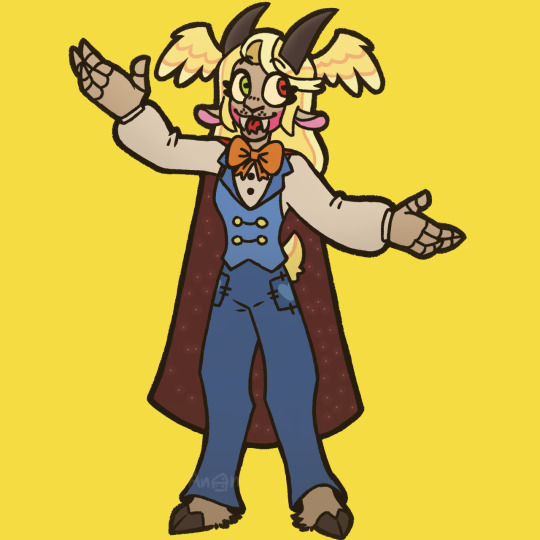
Blue fits Charlie soooo much and I cease to see that many redesigns with this color. I still want red to be used in most of their designs because well. They are in hell, but not too present so to make way for other unique colors. Charlie has several physical traits from her parents but also she has some details in her clothes that match with them. When I uhh, introduce their designs you'll see lmao. I also tried to make her have a more roundish design, I jst LOVE those typ of designs omg. I just want the characters with not too many sharp corners pls Viv bro... 😔 oh yeah she's mixed cuz her mom's are darker in their redesigns. Alot of their genetics went down to Charlie so she doesn't look like an exact copy of Lucifer, I kind of hate that trend with hh and hb characters, like did the moxxies dad give birth to him bro 😭 also I kept her bow because it looks so cute and silly on her it just fits, I wish they made it bigger in her show design because it would fit her silliness so much. She has a cape with stars because morningSTAR smh why didnt they do something fun with that, missed potential but whatevs yknow I still love og designs no matter what anyone sayss. Did you know I love Charlie, I could ramble for days. I think I love Charlie guys. Maybe jst a hunch idk... also... s-snake fangs.. jeepers anddd..... snake tongue.... shiver me timberz
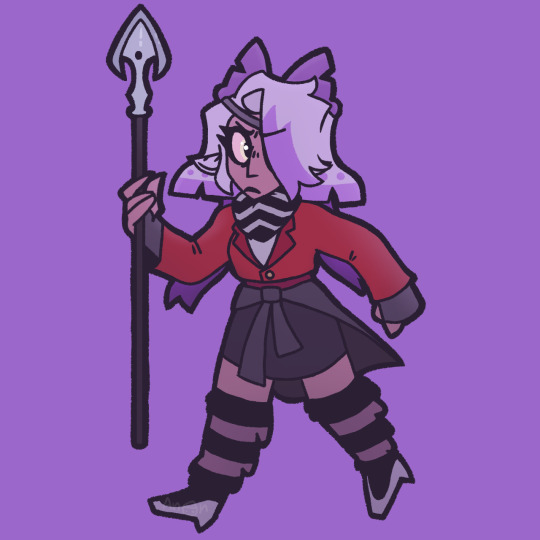
The wife ever. I had animation in mind more when I designed her, not like in a "How easy or hard would this be to animate" way. But I like to imagine when she's shocked her hair kind of fluffs out plus her actual fluff, when she's mad her bow turns into kind of horns and then her jacket expands like wings. Gave her a more hotel like outfit, she likes to work for fun (ew). Her socks are socks but she has some fluff under them she just tries to cover it up because she hates herself 🤪 (she doesn't hate her bigger body she actually feels much more comfortable chubby than when she was skinny with Adam. She was burdened with the weight of Adam's image of women... In this sorta rewrite she gained weight when she goes to the hotel because she's more happy. I'm dying I love chub Vaggie so much guys please) headcanon: she kind of likes fashion, it's like a fun hobby of hers to stitch together clothing and go out and buy clothes she'll never wear. She taught Charlie how to stitch and she SUCKS so you can jst see it on Charlie's pants.

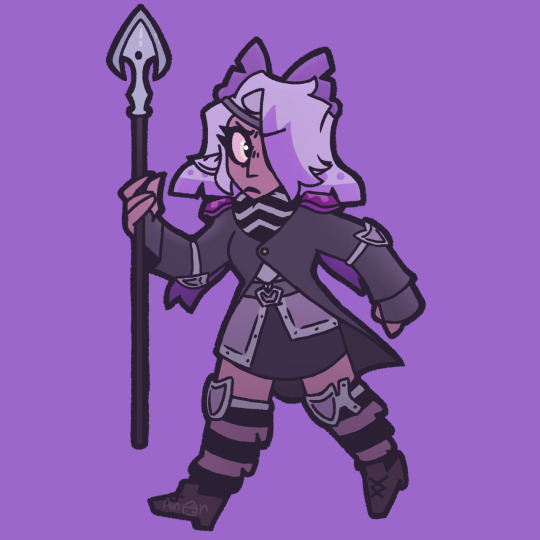
Second outfits! Charlie's hotel uniform for. Well. Hotel stuff. She usually only wears it when new people come to the hotel, which.... isn't often, if at all. She still likes to keep it just in case. Also she goes really cartoonish when it happens, she does the looney tunes run and changes into her clothes in like 2 seconds. Can you see my vision? 😭😭
Vaggie's is in her armor. She has several pairs of armor lying around in the hotel in completely hidden spots. It's kind of surprising uhh. Yeah she wears it alot more than Charlie wears her alt uniform but still rare to find her in it. I don't get the whole thing with the exterminators and them not being able to fight according to Carmilla. Which is kinda stupid, I'm not gonna lie. So, instead of that, Vaggie has just let her guard down and has gotten much more comfortable in her surroundings so she feels like she doesn't need to fight anymore, she's just gotten rusty 's what I'm sayin. I have no idea how to draw armor. You can tell...
Extra below cut vvvv
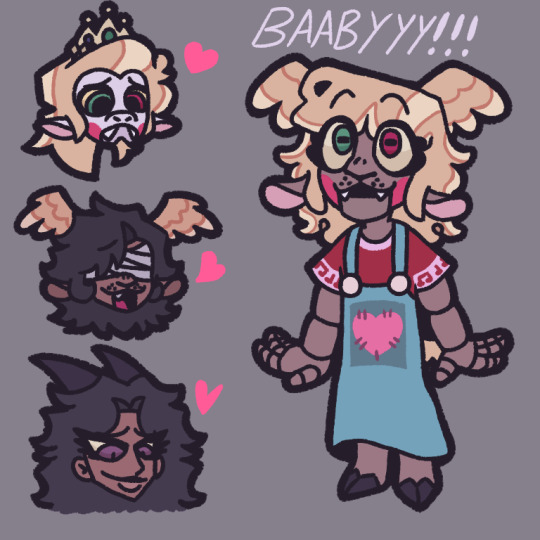
BABY CHARLIE!!! With the heads of my redesigns for Luci, Eve, and Lillith. Haha you still cant see them. Uhh, ill definitely finish the thing one day. Its not even that big of a project thing, i think i jst keep going to other drawings so im like not focusing on one thing lmao. Lucifer has heterochromia because he was cursed to forever be reminded of his betrayal. I only explained that because Charlie has it too, it's kind of a curse on the entire blood line where at least one eye is red. This is like. Slightly older Charlie than the baby Charlie in show? I jst wanted to put her in overalls cuz omg that's jst so cute ughhh 😭😭
#hazbin hotel#hazbin hotel charlie#hazbin hotel vaggie#hazbin hotel lucifer#hazbin hotel eve#hazbin hotel lillith#chaggie#varlie#rainbowmoth#charlie x vaggie#vaggie x charlie#ill get to the other........ one day#art#fanart#artists on tumblr#digital art#charlie morningstar#vaggie#i hate her name. its now Valerie. or was it Valarie. i dont remember. uh. hi#i totally forgot abt my human au ILL ANSWER QUESTIONS SOON YOU GUYS I JST HAVE ALOT IN MIND RIGHT NOWW#lillith morningstar#lucifer morningstar#eve morningstar#WHY AM I SO HAPPY THATS A TAG. ITS LITERALLY CANON THEY WERE PRT MUCH POLY. I JST LOVE THE FACT ITS ACCEPTED 😭😭#hazbin hotel chaggie#hazbin chaggie#lucifers stolen wives#could that be the ship name for those three. or if someone comes up with a better one 😭🙏 im ass at ship names#baby charlie#also every morningstar member has a curse of some kind. sooo ill explain in the other post thatll come out in 2069 /j
83 notes
·
View notes
Text
COCO'S REVIEW: BLUE'S STORY
Welcome to Coco’s Review! Where I review and breakdown episodes, movies and etc and overthink every tiny detail and/or give my thoughts and opinions :D !! THE STORY I’M ABOUT TO DISCUSS HAS TOPICS ABOUT S/A AND OTHER DISTURBING TOPICS PLEASE PROCEED WITH CAUTION !! Ok so this may not be something you’d expect me to cover but I wanted to discuss this series on my blog for a while now! Today I’m discussing Blue’s Story by Victaton!

Blue’s Story is a series by Victaton over on youtube that mixes gacha life 2 character designs along with animation. I like to think of the gl2 designs as character models and Victation expands on it through animation. The series doesn’t have proper episodes, its installments mainly continue music videos that go in a specific order. The story is about Blue, a man in his early 20s entering the company his older sister works in with a positive attitude only for it to fade away as a lot of women in his new job want to get in his pants and cause irreversible trauma on the poor guy. This series is meant to show how abuse in the workplace can happen and how s/a can be done anywhere and by anyone. It seems to be a response to the misconceptions of how men who are preyed on by women are not valid victims of s/a and how they should’ve enjoyed it or that only women can be victims (which is never true). Though keep in mind I’m not qualified to determine if the way the story conveys s/a and just abuse in general is shown accurately because I have not had these experiences myself but my heart goes out to the victims in the world who could resonate with Blue’s Story and I wish for nothing but happiness and peace for you guys. You all are very strong and deserved much better<3
I can tell Victation really touched people’s hearts and according to some people in the comments who are victims the story is pretty accurate to some experiences and some research has been put in this series which I heavily appreciate. So I’m happy people can feel seen with this!
So with this series I want to start off light and mention the animation- AND MY GOODNESS DOES THIS SERIES HAVE AMAZING ANIMATION!
I really love this art style that Vic has going on here

Like I said the gl2 designs seem to make the base and Vic uses their art skills to expand on it It really gives a dynamic feeling and you can hardly tell it’s gacha
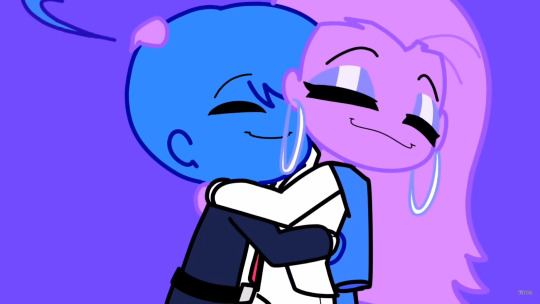
Vic has a lot of dynamic poses and a great understanding of body language with these!
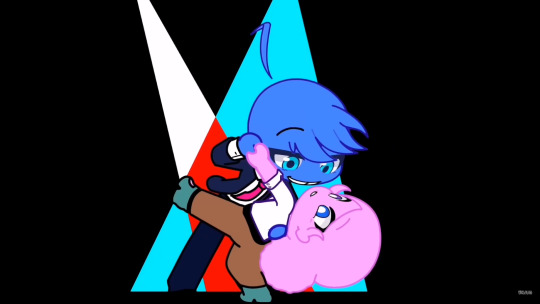

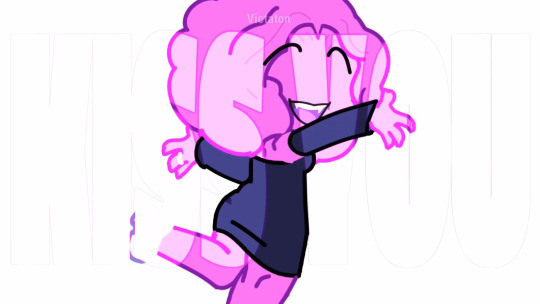
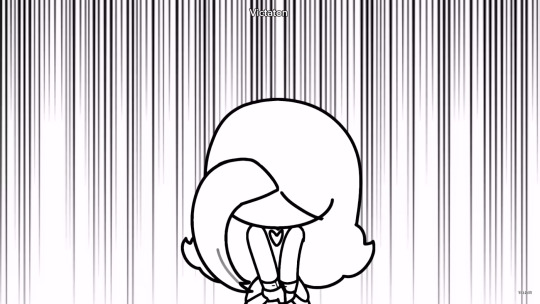
AND THE EXPRESSIONS<33 I LOVE THE WAY VIC DRAWS FACIAL EXPRESSIONS! IM SUCH A SUCKER FOR VERY EXAGGERATED AND STYLIZED FACES


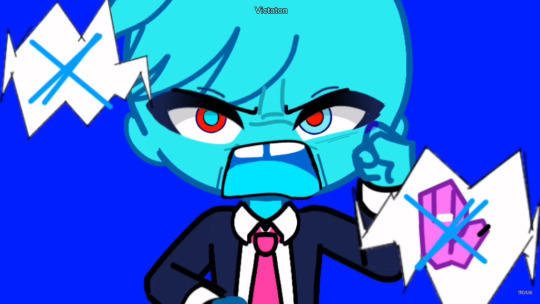
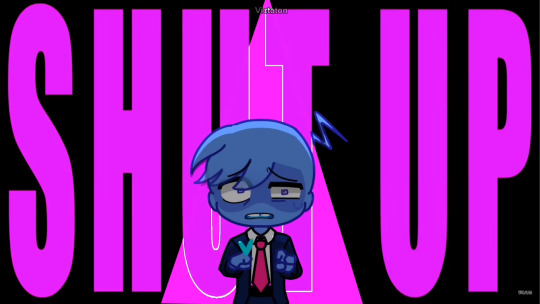
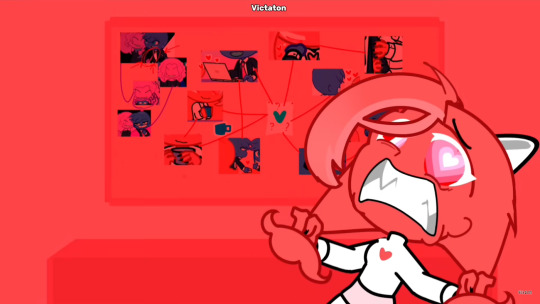
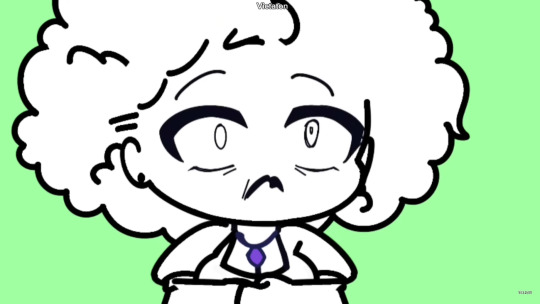
And I’m not even showing the best parts! But I want to keep it as a surprise for those who are interested in watching the series. I just couldn’t stop praising the visuals enough! Vic is the most experimental gachatuber I’ve seen when it comes to the visuals!! I hope to talk with them sometime to get some tips or to post how their creative process works because THE ART IS SO GOOODDDDD! AND THE CHARACTER DESIGNS RADIATE SM PERSONALITY AND ADD TO THE SYMBOLISM AND UNDERTONES OF THE STORY! It’s so fun to see :D and the color associations are a very interesting character design choice! It helps add a very colorful look to what is otherwise a very heavy story and makes it very easy to distinguish the characters and give them certain color motifs. Anyway I want to talk about the characters in Blue’s Story! Mostly by order of their debut! And I’ll only talking abt the characters that have a big impact on Blue (So I won’t be talking abt Magenta or her brother) and the ones that don’t have a definite character (So the red eye people won’t be mentioned) Anyway now that that’s established the character I want to talk about first is well- Blue himself! After All this is his perspective we’re following

Also quick appreciation for the silly little Blues that Vic draws<3 Anyway Blue is the most interesting character I’ve seen in a gacha series. I like how Vic doesn’t use Blue as a representation or a role model for victims to take after but a person who goes through his own stories and has room to be human. You can see his descent in his own trauma and self loathing in his story. Which leads him to make mistakes and have a difficult time navigating his relationships and how to make meaningful connections. Seeing him go from confident and upbeat to quiet and reserved is so heartbreaking. What I find so great about Blue is that not everyone can relate to his situation but his thought process is near universal. I can relate to having to be in survival mode when it comes to relationships after being done dirty by different people. Not to mention people would do the same things Blue did, they just went through different experiences. It’s a really great touch to the writing. What’s also interesting I find about Blue are these different personas of different ways he handles the trauma caused by all these women.

This is sorta a mix of my interpretation of what these versions of Blue are plus what Vic actually calls them From left to right 1.Hypersexual Blue (confirmed) 2.Heart Eyes Blue (confirmed) 3. Reality Blue (not confirmed) 4. Cyan Blue (confirmed) 5. Numb Blue (not confirmed) I’ll expand more on these personas when I do a character study on Blue (which is something I REALLY wanna do sometime)
Next up is Pink Who is the first character we meet when Vic started this series
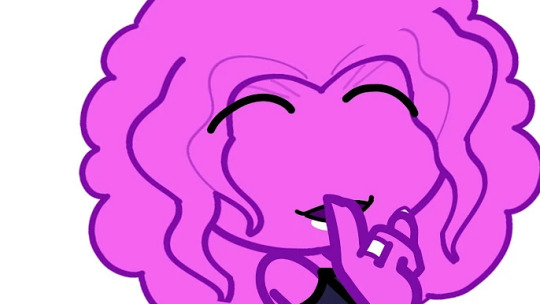
Pink is a married woman around Blue’s age who he engages in an affair with. And one of the women Blue has a significant relationship with throughout the series since Pink was the first one in the workplace to have her way with Blue. A truly manipulative bitch 💀 I don’t have much to say about her because Vic themself made a video discussing the women in Blue’s life and their thought process on writing them(?). So I’ll just give my thoughts! Pink is a very interesting case of the “Abused to Abuser” situation and not to mention how she’s not one dimensional. She’s an abuser to Blue but also a victim to a different man. (her husband) There are scenes where she is being a nice person (highlighted with her scenes with Lilac) but what’s preventing her from being good is her philosophy of how men cannot be victims. How could they be? To her the most heartless person she knows is a man, while it’s close minded, it’s understandable but not excusable why she perceives men this way. Which I find very interesting! There’s also a cool animation choice with her lipstick color! Her lips are white when she’s doing nice things or is not perceived as a bad person, then grey when it’s more neutral (I think) and finally black when she harms Blue. Hence why her kiss marks start from white to black.
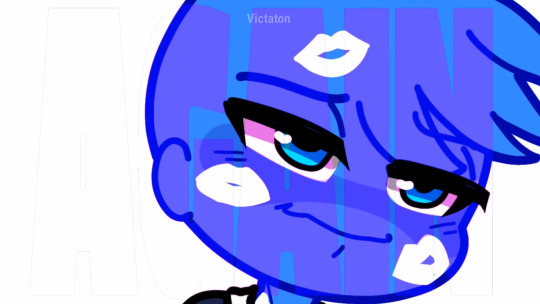

What’s also interesting is that Blue pursues her first! Since he started out so confident and upbeat he wanted to try and shoot his shot with an attractive woman. But backs off when he learns that she’s married, but things didn’t go as planned. But I find it very interesting how that’s how things started. Next we have Purple who is the CEO or just the boss of the company Blue works in

Purple imo is definitely the most uncomfortable character to watch (what am I saying ALL the abusers make things uncomfortable to watch) but Purple just gives me a chill up my spine. Especially with her design, it has been confirmed by Vic that Purple is in her 40s and would prey on much younger people. First she attempted to prey on Red (who is confirmed to be 19), but was unsuccessful then went after Blue, and was successful.
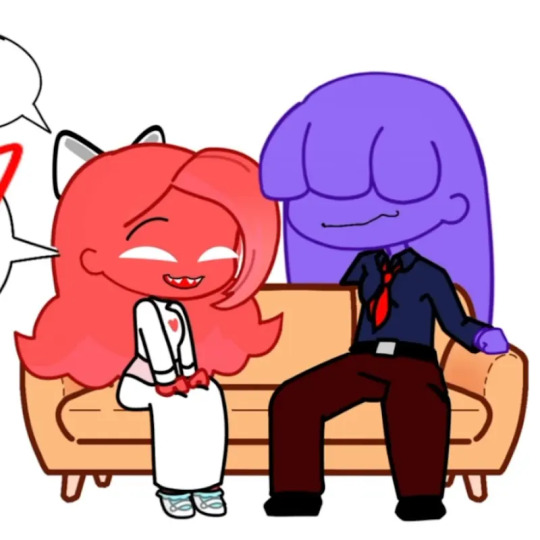

Not to mention she’s very inconsiderate of her workers, example in the second part of “Baby Hotline”.
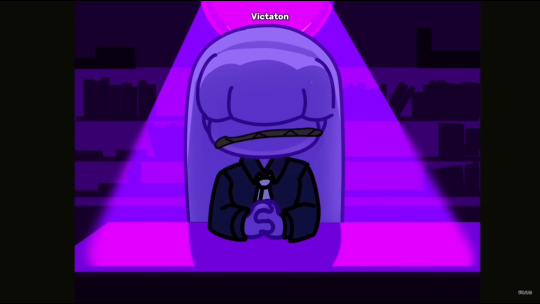
Up next we have Red! Who is my personal favorite in terms of how she is written and her design! (I do not condone her actions)
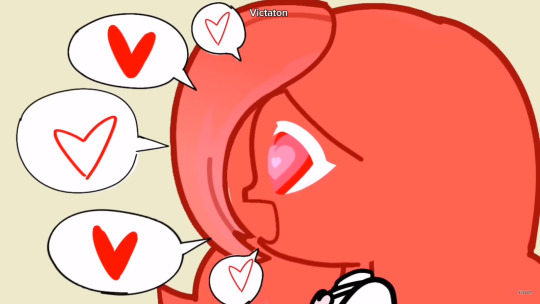
I love how Vic went for a more cutesy innocent look for Red!

But not without giving her sharp black nails to show how harmful she is
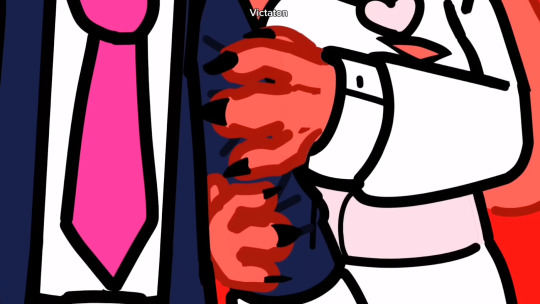
It really nails the message home on how anyone can be an abuser no matter how they look like. I also want to appreciate her little heart eye effect that Vic does with her that’s constantly looping like HOW DOES VIC DO IT- IT LOOKS SO DIFFICULT TO PULL OFF- I’m guessing it’s green screen With Red she is an obsessive stalker who has feelings for Blue and is constantly pursuing him even if he doesn’t return the feelings. It starts off as an innocent crush but turns into something more harmful. I don’t have much to say that’s not been said by Vic on their video. I just really want to appreciate how well designed she is and I rly like the heart motif she has. You can tell she’s a naive girl who can’t understand how harmful she is. I’ve met someone who was my equivalent to Red and while thankfully I had people who managed to protect me, doesn’t mean the harm did not get to me. While they were not as intense and Red, I was still being harassed verbally and I just didn’t feel safe. ALSO HOW DOES VIC DO HER HEART EYE EFFECT I NEED ANSWERS Now we have Lavender who is Blue’s SISTER
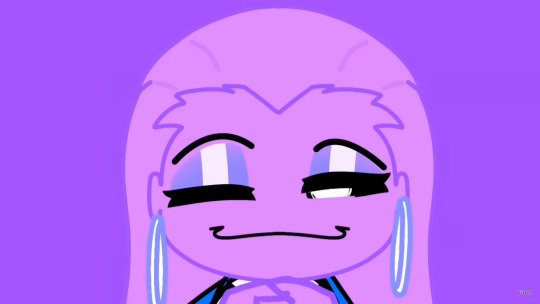
YEAH THATS RIGHT- SHE IS BLUE’S SISTER And I swear everytime I see her I just want to punch her in the goddamn face and wipe that stupid smile off her face- Lavender is an example of non-physical s/a and incest with how she had sexual thoughts about Blue and would show it through more subtle actions. Not to mention she’s also a bystander to Blue being abused by other women and doesn’t do ANYTHING about it. As an older sister myself with my own little brother- Lavender ENRAGES ME! I could never imagine doing what she did to my own brother. He drives me crazy but I’d protect him no matter what. What is fascinating about her design is definitely how her eyes are constantly closed, as if she’s turning a blind eye to the harm Blue is a victim of and/or how she’s hiding so many things. Especially with how she only opens her eyes when she’s preying on Blue.
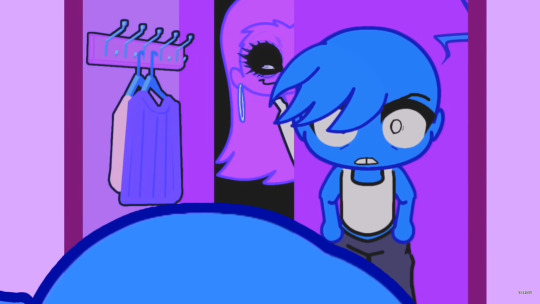
SHE'S JUST AS TERRIFYING AS PURPLE Lastly we have Lilac! Who debuts in the same video as Lavender
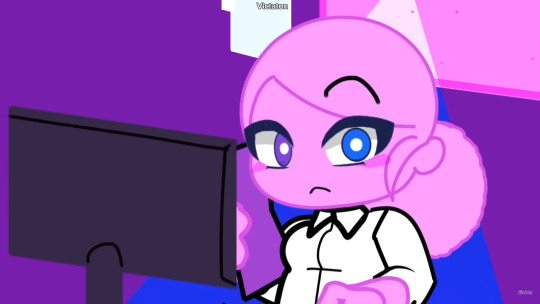
WHO IS THE ONE PERSON THAT DOESN’T TREAT BLUE LIKE SHIT She’s a very fun character! She’s a single mom who works in the same company as Blue. She has a lot more significance in later installments so I won’t spoil but I just love her<3 She’s so sweet I just can’t- it’s such a breath of fresh air compared to the toxic waste Blue’s been getting from the other women. Her relationship with Blue is so interesting to watch and I am just rooting for them to at least stay friends.

(Also she looks so pretty here) AND THAT’S ALL THE CHARACTERS!!
Overall I really enjoy this series but I do have some gripes with it. The pace is definitely a bit much- so much can be happening in a span of a few mins. And there are stories that could rly benefit a longer time limit. This problem comes up most with “Baby Hotline” where I hardly understood what was happening. Like I got the gist but I didn’t get the specifics. It can be difficult to keep up with. So yeah the series could work with a longer timeframe- “Sweet Little Bumblebee'' is a great example! Not everything is too fast and everything makes more sense while “Baby Hotline” tried cramming a lot in one minute. Well the first part of ot, the second part of “Baby Hotline” was at a much better pace in my opinion but still a bit hard to keep up with at first.
Anyway in conclusion! Blue’s Story is a really interesting story that deserves the recognition it gets and is worth your time if you are into really deep stories with heavy subjects!
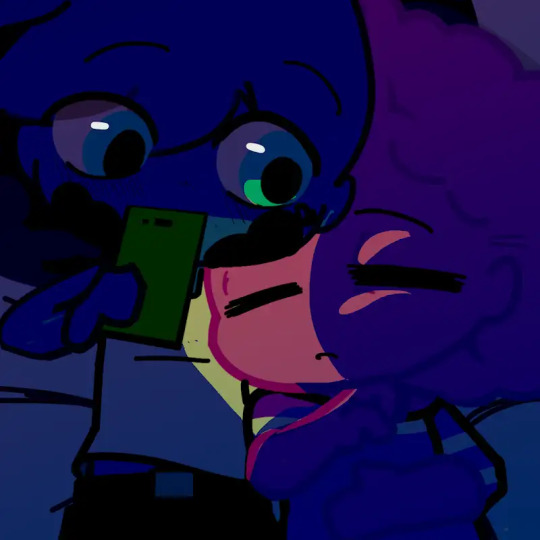
(Credit to Vitaton for all the art presented) This is Coco typing.. Thank you for reading!
37 notes
·
View notes
Note
You wanna do an analysis on one of your faves?
Do one on Samus! It's the right time!
Of course :P
Well... Samus is hard to describe, because she has changed so much in three decades.
The general Power Suit is iconic for a reason. In the older games, it was bulky, not apt for speed but very much apt for exploring a hostile world. It made Samus look like an advanced, cold, deadly robot.

Nowadays that people are inherently born with the knowledge that she is a woman :P her Suit has become a tad more feminine, mostly in the hips department - not enough to look too booby, but enough to be more streamlined and agile. (the size of the Varia Suit's massive shoulders is to this day wildly inconsistent :P)

Not surprising, then, the direction took in Dread, where the suit is sleeker than ever: Samus doesnt' look unprotected, but she's elegantly stripped to the essence without losing her cool factor.

You can tell in which decades those suits were designed :P
But I find Samus herself more interesting.
I remember reading a thread on r/metroid of someone, who was probably eaten for dinner that day, who was glad that Samus looks very feminine under the Suit, because you wouldn't expect the big hero of the galaxy to look like a cute woman, especially coming out of such a cold robotic suit. I do see their point. In part, her design (blonde, blue eyed, slim, conventionally pretty) is a child of its time. I think nowadays she would have been designed to look more like Abby from TLOU2, and I mean it in the most neutral of ways: Samus, overall, feels like a male character who was genderswapped at the last minute. And yes I know that it's exactly the case because the big reveal in M1 was mostly a joke, but I mean writing wise too.
My favorite design for Samus will always be SM, because yes, I do like my Samus to be athletic:
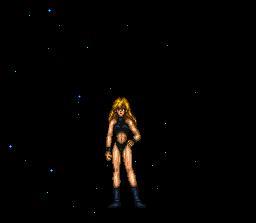
She should look well trained, for the job she has, and I wouldn't even mind more scars on her body, especially of the Phazon kind. (also I'm biased because I like buffer women :P) This is also where I insist that the two-piece looks better on her than the Zero Suit: while admittedly the latter would protect her skin better under the Power Suit, aesthetically the two-piece draws your eyes on her toned limbs and stomach, so while it is more revealing, I feel it's a more "tasteful" kind of fanservice than the Zero Suit which clings onto her curves. (not to open a can of discourse, it's my personal preference)

But I find interesting that she keeps her hair long and she puts on make up. Think about it: why would she put on make up when her face is hidden to the rest of the galaxy? No matter where she learned it, whether it was from the Chozo as something culturally different from our make up, or from female companions when she trained in the GF, it's easy to guess that Samus likes her appearance and puts care in it for herself and herself only. I do think it fits what we know of her personality: she's not a showoff, but she's not humble either. Combine this with the previous talk about the two-piece: Samus is shown going around places like that. Overall, both in appearance and personality, she exudes masculine confidence in a feminine way, something that would be so easy to mess up, but with one exception it has been kept fairly consistent.
25 notes
·
View notes
Note
We're still undoing the damage done by Teen Titans 2003, I think. Jinx is another Indian sorceress from that franchise and they've really only *just* stopped whitewashing her. Starfire with afro-textured hair is still a hit or miss but with black women recently being used as a base for her visually (Zendaya, Rihanna, Anna Diop) it seems to be getting better.
Raven definitely got the worst of it though- she used to wear lehengas and saris all the time with pastel colors and actually looked Indian (Persis Khambatta, the actress she was based on, was relatively light skinned), now she's been claimed by the goth/witchy aesthetic with the purple hair and grey skin. She wears upside down pentagrams. And pants, even though I distinctly remember her hating pants and preferring skirts and dresses. She's unrecognizable- Marvel's taking measures now to fix Wanda, but DC isn't doing the same for Raven. She recently got her classic look back but I have no idea if it's sticking around.
The Jinx character in Teen Titans is so weird. This is on me, because I'm just not as much of a DC reader, but I legit believed that she was a random OC that was intended to be a Scarlet Witch knockoff. Because they give her, like, a reductive version of Wanda's hex power, and she's designed in the same 2000s goth vein as TT Raven and Evo Wanda.
But anyway, yeah, for all its merits, Teen Titans really did a number on a lot of Black and brown characters, and Raven's had it pretty rough for a long time. I was so surprised that the gender-bent version from Teen Justice was actually designed as a South Asian character with darker skin, but I was also completely unsurprised that he immediately started getting lightened and whitewashed.
I'm not totally sure how I feel about Raven's fashion choices. Her traditional clothing is important, but in the current continuity, she's a young adult who, to the extent that she's lived on Earth, mostly grew up in America. So I understand the impulse to make her feel a bit more youthful and contemporary, and I think it's possible for a character to explore different styles, especially alternative fashion, without compromising their culture and ethnicity. Obviously, the first step would be to stop drawing her like a white girl. Or a Monster High doll, for that matter. But I'm not an expert on the character-- sound off if you think I'm wrong, I guess.
11 notes
·
View notes
Text
Rating Every TNBA Redesign Cos Why Not
The New Batman Adventures was the last season of the infamous Batman the Animated Series, although it moved to another less strict network. Because the producers wanted to do crossovers with the Superman animated series, they gave the series and its characters a more streamlined style to it. Now I dont wanna blame Bruce Timm entirely since there were many artists on staff back then who did the redesigns but because I hate this coomer, Im going to anyway. In BTAS, you can tell each character apart and they have their own unique outfits and looks to them. But here, these are some of the most unimaginative superhero/villain designs Ive ever seen. Although some did surprise me and were not that bad. So, for a bit of fun, here's my look at each Batman character's redesign in the final (and worst) season of the show.
(Not counting Robin cos he's a different character to Dick Grayson or characters that had very little changes like Clayface or Harley Quinn)
Batman
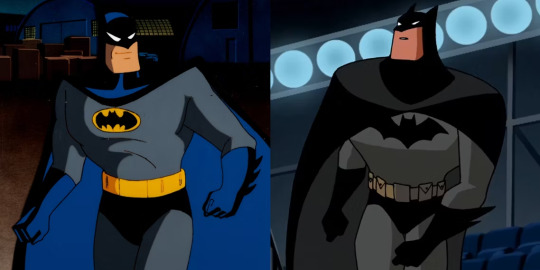
The big emo rodent himself. For his redesign, I like the more sleek look to Batman's cape...thats it. His original design is really hard to perfect. Its got everything. Why tamper with perfection?
Batgirl


I actually kinda like Batgirl's redesign. The yellow gloves and boots really help her stand out and its the one of the few times the darker toned outfits actually accentuate a design rather than ruin it. Too bad Bruce Timm couldn't stop salivating over her and the rest of the women in this show. So next time you see someone consider Bruce Timm this legendary storyteller of Batman, give them a healthy reminder that he shipped this college girl character with her mentor/surrogate uncle figure FOR YEARS.
Alfred
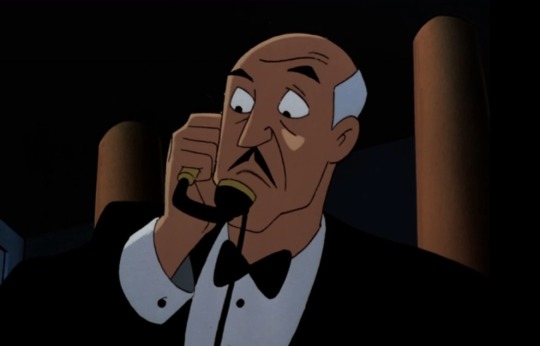
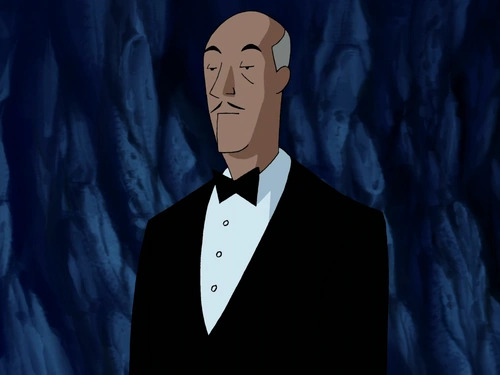
Its like they sucked away all of Alfred's snark and replaced it with a cardboard cutout. Literally, he looks so sterile and empty. Who had the idea of making Alfred look more bored and done with everything? Also whats wrong with his chin??
Commissioner Gordon
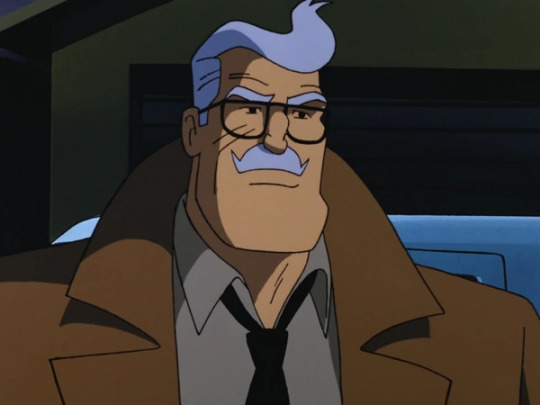

Good ole Commissioner Pringle got off pretty much unscathed but I think they made him a touch too old considering they gave him a more lanky body, which makes him look more feeble and weak. Dude looks old enough to be Babs' grandad
Joker


Ohhhhh boy. So Joker's redesign is infamously considered by fans as one of the show's worst redesigns, to a point even the showrunners were like yeahh. And thats not unwarranted. He looks like an inverted Dr Draken and im so glad they redesigned him again for Batman Beyond and onward.
Seriously he's A CLOWN WHERES THE MAKE UP?!!
Two-Face
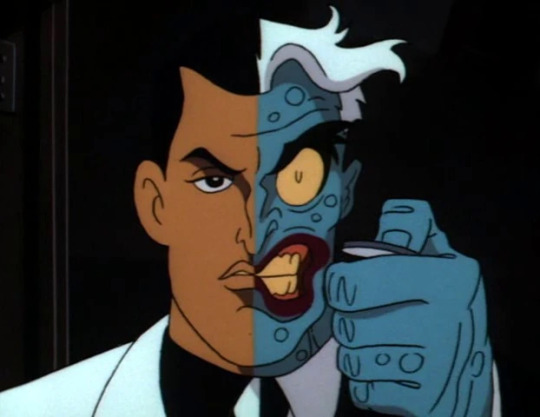

I know Two Face is just a redrawn version of the original design with the TNBA streamlined art style but I want to draw special attention to the monster side of Dent's face. Notice in the original it looks more manic and feral? Heavily contrasted with the conflicted, guilty look on Dent's normal side? But here, in the redesign the monster side is less scary and Dent looks way too bored and angry. The overuse of black lines doesnt help.
Catwoman

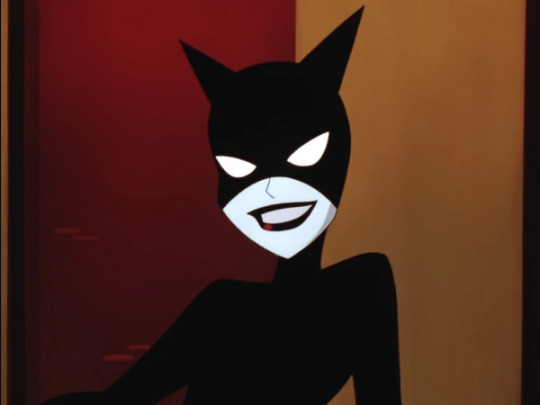
She looks like Harley Quinn or Barbara wearing a catsuit. Starting to see a pattern here?
Baby Doll

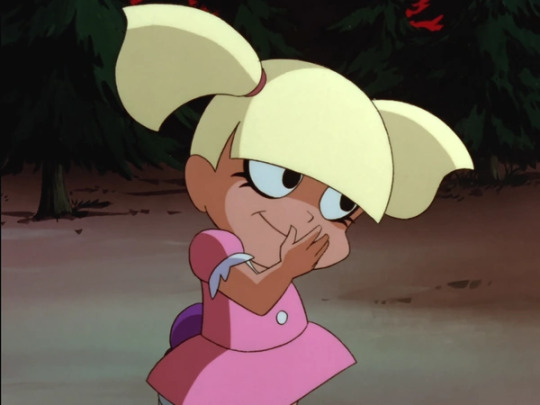
Its a tough call cos they both look very good but Im gonna lean towards the redesign cos shes got that creepy doll look down to a T (Annabelle would be proud) whereas her original design looked more like a Tiny Toons character.
Scarface and the Ventriloquist
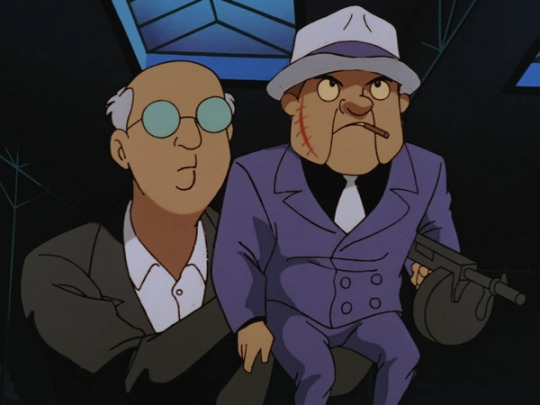

I like the redesign cos of the exaggerated style of the rest of the show perfectly captures Scarface since he's, yknow, a puppet and having the Ventriloquist be shown to be scared and submissive really does show how the puppet is ironically the puppetmaster.
Penguin
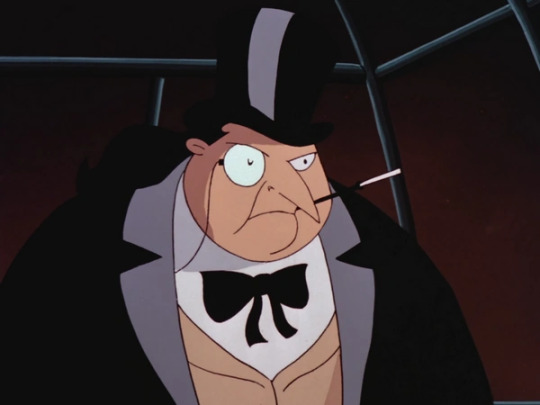

Actually I like both of them. They both give off that sophisticated element Penguin is known for and after so many reiterations of him being this crass Scouse-talking crime boss, its nice to see versions of him going back to his rich asshole roots.
Bane

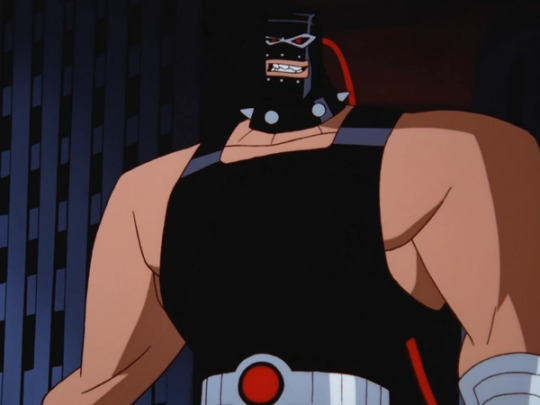
In the original, he has a luchador-style mask and wrestling suit fitting his Spanish roots. Here, he straight up looks like a gimp. Its really bad. Embrace your heritage, Bane!
Riddler
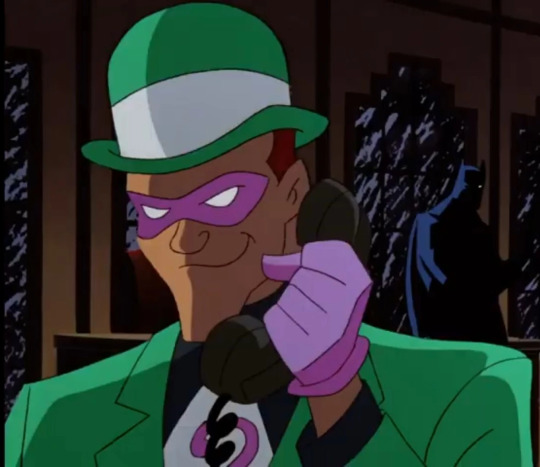

They went from Frank Gorshin to Jim Carrey for Riddler (fitting cos Batman Forever came during TNBA's development) and I love that. So I love both of them. Nice to see a villain with some fucking colour in TNBA cos im tired of seeing all this black outfits. Also his cane being an extended question mark instead of a question mark on top of a regular cane is genius.
Mad Hatter


Both of them fit Hatter's deranged stalker vibes perfectly, but I wish they kept the colour scheme for the redesign cos Hatter's new colour scheme looks too rounded and doesnt stand out.
Poison Ivy
Killer Croc


Finally, now he looks like an actual crocodile instead of whatever the hell he was supposed to be!
Scarecrow
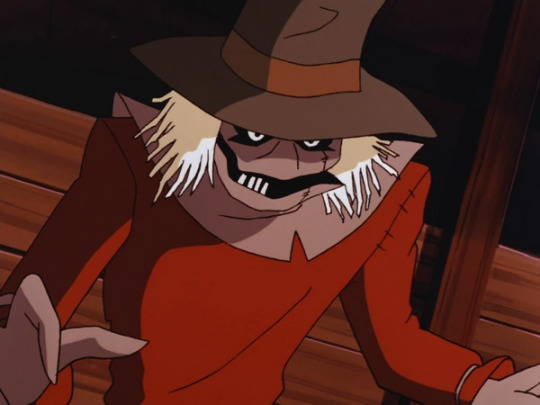
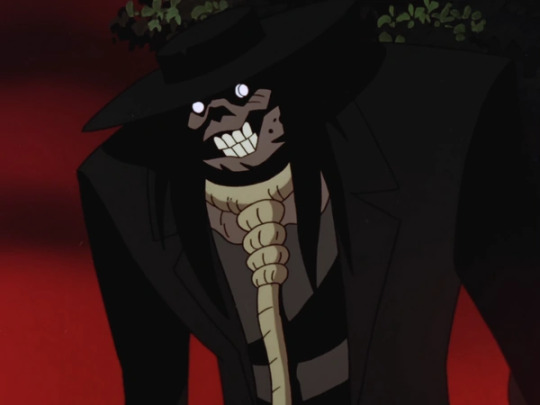
Okay, who the fuck decided to make Scarecrow look like the Babadook? Cos I want to give them a raise. Holy mother of piss, that is terrifying. That shit belongs in the Arkham games. I still prefer the old design cos it has that perfect blend of goofy and gothic. He looks like a Cacturne now that I think about it.
Mr Freeze
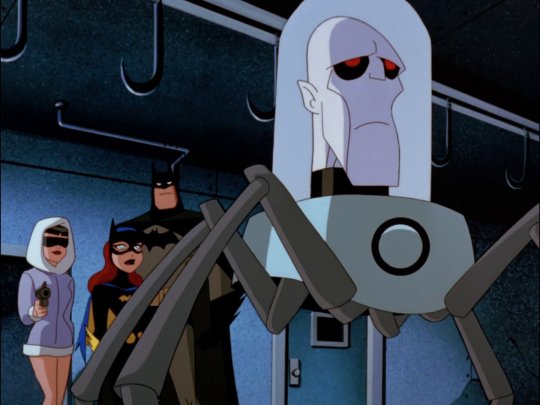
HONEY WHAT HAVE THEY DONE TO YOU?!! WHY DO YOU LOOK LIKE A FUCKING FUTURAMA HEAD?!! WHAT IN THE ACTUAL FUCK?! YOU HURT MY HUSBAND, TIMM, NOW ITS PERSONAL
#batman#batman animated series#btas#the new batman adventures#tnba#batgirl#commissioner gordon#catwoman#joker#riddler#two face#penguin#the scarecrow#mad hatter#ventriloquist and scarface#baby doll#poison ivy#bane#killer croc#redesigns#mr freeze#also freeze's suit looks so robotic and lifeless which I know that was the intention but it still looks boring as fuck
161 notes
·
View notes
Text
ok, gonna try my hand at compiling my thoughts on fist of the north star first. here goes nothing! warning, this post is gonna be Long, open the read more at your own peril.
i think the best way to go about this might be roughly chronologically, so i'll start at the start. i think it's interesting how very early on, the conceit is "there is but one practitioner of hokuto shinken and but one practitioner of nanto seiken, and they are sworn to never fight lest the world fall into Chaos..." and that degrades very quickly past the first arc. i will say that overall, the shin arc is a very fun, enjoyable and relatively quick watch, with mostly interesting fights, decent character designs and a mostly compelling narrative. i think one of the standout parts, to me, was when shin was actually defending yuria from his former goons while they tried to revolt. it definitely added a certain texture to shin's character where he had previously been just 100% straightforwardly the bad guy, instead of being 99% that. also there's the devil rebirth fight and that time ken killed The Entire United States Military in the same episode that he punched a wrecking ball so hard that it shattered like a christmas ornament. now that i think about it, the leader guy of the former US military was actually probably the first time we see nanto seiken used by someone who isn't shin, and i remember it being kind of a big deal that shin had violated their sacred traditions to such an extent, y'know? how quickly that went out the window
something that's been consistently good in the series was the music. the fight music, the ambient stuff, and especially the openings. all 3 of the openings are S tier, but i will say they never quite top ai wo torimodose, it's just that fucking bombastic and fun, y'know? at the same time i wouldn't stab somebody for thinking silent survivor or TOUGH BOY are better, they're all fuckin great even if in different ways at time. honestly i'm mostly surprised that an anime from back then had more than one opening, much less 3. from what i can tell that shit wasn't nearly as common back then as it was today, so i think it speaks to how deeply popular the series was back in its heyday. hell, OG dragon ball got just one and im pretty sure DBZ barely got two. i hope one day i'll be able to make music as stellar as the hnk soundtrack, really.
something that bugged me about early fist of the north star is how every fucking woman looked like yuria, just sometimes with different hair. this definitely got better as the series went on, and i have no idea if this was a problem in the manga too, but by god is it glaring. thankfully that seems to clear up ironically after mamiya is introduced, who is explicitly portrayed to be the spitting image of yuria. i think the first time i noticed that women finally look like unique people and Not Just Yuria was that one martial artist who fought with roses and shit. side note but i genuinely loved her design, the show got really sexist about her being a Femoid who fights but setting aside that i really loved her. i should learn to draw her. anyways, i like how the series improved over time in that regard, at the very least
one of my biggest problems in the series starts with shin's death. i remember when shin first died and he burst out crying, i had assumed it was just a fucked up manipulation tactic like the yuria doll, but apparently we the audience were expected to take it seriously? and like, this began a longrunning trend of a villain being like, absolutely irredeemably evil, like puppy crusher machine, baby eating, torment nexus evil, and then at the end they're all like "i just wanted 2 play on de play groundt...." and we're expected to take that seriously???? like, i'm all for moral nuance and complexity, and there are times where this whole shtick was done more tolerably than others, but in my opinion they never actually redeem somebody in a way that's satisfying. a redemption arc has to be, y'know, a fucking arc. and even if you're trying to do a redemption = death thing, the thing that makes that trope work is that they die doing something, y'know, actually good???? the reason anakin's redemption worked (aside from actually being foreshadowed pretty blatantly) was because he actually saved lukes life and died in the process. he did a good thing and died because of it. meanwhile shin, he still fought ken right up until the end and acted like nothing was out of the ordinary until he was literally seconds from dying. at least raoh had it built up to a little bit, like jesus fucking christ.
now, i will say that the arc from roughly jagi's introduction to the first fight with raoh is the best fist of the north star gets. if you're thinking about watching the show but don't wanna commit to 150ish episodes, i'd recommend watching from the beginning right up until the end of the first raoh fight. i feel like that's still be a pretty compelling 50 or so episodes, and it has literally all the best bits within it. honestly kinda sad that the show peaks approximately 1/3 of the way through it, but what can you do. anyways, enough backhanded compliments; jagi is probably the best all around villain in this series. he's an absolute bastard, he's one of the first characters in the entire show to just straight up pull a normal gun on people, and he inspires one of the most cathartic moments in the entire show. this is around when we first get into like, the soap opera shit, right? first it's a bit contrived but still cool as hell that rei is a new nanto seiken practitioner, aside from That One Scene he fills the deuteragonist role pretty nicely and is honestly the gold standard by which the rest of the series' guys can be judged off of. he's no ein or juza, but to be fair basically nobody is.
anyways like, that cathartic moment i was talking about. it was just after jagi admitted to ken, taunting him with the fact that he's actually the reason shin kidnapped yuria, and he's the reason yuria died. this, alongside the "actually the main character has 3 secret brothers that we just havent mentioned until now, and theyre ALSO hokuto shinken practitioners" is very like. soap opera/bad fanfic-y, right? but it works because in execution, it's still pulled off well, and we're still nowhere near the bullshit horizon we'd skyrocket past by the end of the series. so, when ken's finally killing jagi, there's a moment where he says something to the effect of "this is for yuria, and...." and you just know what he's about to say next, but he hesitates, and when he finally says it it's so damn satisfying, "and for me!" and the thing is that it's a deeply compelling moment for a variety of reasons.
so, the thing with fist of the north star is that, in a lot of ways, it's very analogous to a superman story where the question is almost never "will the main character lose this fight" because he's so insanely fucking broken, right? the real question is, "will this character protect those he cares about in time", that's where the tension comes from, and it comes from the fact that he is in fact a hero. that's how you write a compelling overpowered protagonist, you give him either people to love or just a love and respect for all life in general and so that always gives you stakes. i get that to a lot of people, the question of "will ken save this nameless chicken farmer?" isn't a very compelling one. but to me, it is, because he cares so deeply about it that i start caring about it. in the words of aphex twin, "i care because you do".
so, the thing is up until now ken is a very selfless character. it's to such an exaggerated degree that it becomes fairly evident that he has very little regard for his own safety or wellbeing. in the first arc, aside from helping whoever he happens across he's motivated exclusively by rescuing yuria. every fight he has up to this point isn't even for himself, really, and there's something almost sad about that. he doesn't allow himself to have needs. so it's actually very satisfying to see this strong, principled man admit that he has in fact been hurt, and that he's not just doing good for those around him but for himself as well. and it's a very natural character progression that you don't even realize is happening but also makes complete sense. there's something deeply compelling to me about a man so devoted to helping others that he has to actively learn how to live for himself, y'know? i feel like that's a relatable struggle to a lot of people, really
i will say i have one gripe about the jagi fight, and it's that it's almost perfect except for the fact that jagi dies laughing. at first it's seeming like he's gonna die in agonizing misery like he deserves, and it's satisfying well up until the point he starts to laugh on the way out. and like, i understand why it was done that way, and i'm pretty sure it was meant to be haunting, but it honestly just felt like it undercut an otherwise great moment, y'know? i want that motherfucker suffering god damnit, its what he deserves.
there's not much to say about the arc up until the first raoh fight, really. toki is really fucking cool, i love me my apocalypse karate jesus boy, and the fight with that uighur guy was really good setting aside the weird racial thing of having a character that's of a certain ethnicity and just naming them that ethnicity. like, imagine if there was just a guy in a show named Jew, and he's canonically supposed to be jewish but it's never really addressed, like that'd be weird right
i will say, the raoh fight was fucking precious, easily the best part of the entire series. it has this amazing and complex rhythm to it, where every character who tries to fight raoh ends up trying their own self sacrificial bullshit move only to be thwarted by the next guy, until there's essentially like 3 or 4 different fights going on at the same time. it's also nice seeing ken get straight up hard countered for once, like straight up he gets just as fucked up as raoh does and it makes raoh that much cooler of a villain. up to this point, ken is like, essentially invincible. he's basically post apocalypse aikido jesus, poking people so hard that their disabilities are cured and punching people so hard that their entire bodies explode like he's got the bloody mess perk. so to see someone even break even with him is a damn impressive thing, it instantly establishes your villain credentials y'know?
the thing about raoh is that i love him, very much, but i very much hate how he was handled near the end. the fights with him after the first one are very eh, the penultimate one is close to satisfying but then there's that whole "and then he randomly got away with yuria and now he's gone!!!" bullshit, and i get what the final one was going for and it's kind of built up to but i still didn't exactly like it, y'know? for what it's worth, raoh's redemption arc was probably the most well set up in the entire series, but it still wasn't actually y'know. good. like, the way we're introduced to him is by him being Ken-Oh, King of Fists, and he's this fucking tyrant who recruits people to be his slaves by giving them the ultimatum of "willingly brand yourself as my property and then be my slave for the rest of your short life or get burnt to death", and we're shown that his goons are inches away from burning lin, a literal baby child, to death. and we're supposed to just buy that he's actually not that bad at the end???
like, something i wish this series would just fucking do would be to have their villains just fucking own their villainy right up till the end. they do it before the end!!! one of the first bits with shin has him literally monologuing about how cool & good it is to be evil before busting out one of the greatest evil laughs i've ever heard from a voice actor in any media ever. the best villains are pretty consistently That kind of evil, like the kind of evil that'd make the average disney executive go "hey maybe we can chill a bit out here real quick", and that'd be wonderful if they were unrepentant about it!! it feels really forced!!! imagine if like, frieza, before the bitter end, went all "hmm, maybe i do regret blowing up planets and spending my days being space hitler...." that wouldn't've fucking worked!!! there is, in fact, such an intense degree of evil in fiction that it just doesn't make sense for them to immediately go "hmm yeah i'm a good guy now. right before i die. how about that :)". it's deeply unsatisfying every fucking time, like my god
there's something to be said about the queer coding in this show. i remember in one of the earlier episodes, there was this bear dressed as a BDSM cop and his two goons were scantily clad twinks, and internally i went "haha that's kinda gay" before he straight up kisses random dudes before he kills them. and it hit me like "oh. he IS gay..." and it's like. i don't think that's even the gayest thing in the series, really. there's that one scene where two fang clan dudes are checking out rei and the one with the binoculars is like "woah, this guy's real pretty!" and the other dude is all "well, not as pretty as me right bro???". and then there's just yuda, in general. relatively uninteresting villain, but him dying in rei's arms admitting that his motivation in trying to kill him was that he was the only other man who he found beautiful, like. i don't think there's a heterosexual way to interpret that, really! and that's even setting aside the hideous makeup he's always in! and that's not even mentioning yuria's brother wanting to "see what she(yuria) saw in him (ken)" and as a consequence, wanting to die by his hands. also ein is a bisexual icon who canonically thinks ken has a pretty face and i love that for him
the next bit after yuda was, i believe, souther and shu. now, i think souther might've been the only villain to outright defeat ken up to this point, and i think there's something that could've been interesting about that if souther just wasn't like, aggressively fucking boring. i think he's also the introduction to ki blasts, so that's cool, but the most interesting bits about the souther arc were the bits with shu. shu was a homie, very speedwagon-esque in terms of vibes if not functionality, i liked watching him at work. i will say that shu was probably the point where nanto seiken was wearing out its welcome, we're at like 4 or 5 guys whose main deal was nanto seiken and their entire fighting style could essentially boil down to "cut em into bits" and the only real variation was the shape of the bits people were cut into. i think this might've been the prevailing attitude at the time too, because they definitely pivot away from nanto seiken after this in favor of other, usually dumber martial arts
i will say that this series is, usually, very good about respecting character deaths. with one piss stained exception, characters pretty much always die and stay dead forever, meanwhile i feel like in series less committed to death mattering would've still had toki or rei around by the end of it. the exception is, of course, yuria. it was to give yuria and ken a happy ending, at least for a little while, and honestly while i kinda hate the concept the execution was still fairly competent so i didn't outright dislike it overall. i think it's stupid and retcon-y and at times feels like yet another excuse to make shin seem like less of a bad guy, but it still felt nice to know that yuria got the spend the last few years of her life with the man she loved
i liked ryuga for what he was, mostly just because he wasn't yet another fucking nanto seiken user. he's probably about on par with the elemental guys that'd go on to die to raoh, juza excluded. which brings me to, the man who is tied for Best Boy, juza of the clouds! i.e., my current profile pic. i like juza. he's probably the best thing to come from the series post the Peak arc of jagi to raoh. one of my first criticisms of the characters in this show was something to the effect of "look, if you're a handsome, muscular guy who's also ungodly fucking powerful in terms of martial arts in a world where martial arts is fucking magic, And you're in a post apocalypse? all i'm saying is that you could have basically any girl you wanted CONSENSUALLY, like seriously shin just ditch yuria and build yourself a harem of all the women that look exactly like her". and juza did exactly that, and i love him for it. i'd like to think i'd be like juza, in his universe, not quite the top of the totem pole in terms of raw power but still well above every normal person, saving women from being abused and letting them join my harem if they want, living in a fucking castle with a pool/bathing house? that's the dream, man. that's the fucking dream.
now, that's setting aside juza's whole "wanting to fuck his sister" thing. like, to be fair, yuria's his half sister, but seriously dude what the fuck is it with everyone in this show and yuria. ken and all 3 of his brothers were into her, juza was into her, shin was into her, if there is a man in this show and he knows yuria there's like an 80% chance that he wants her. what's the fucking appeal? like yeah, she's pretty, sure, but so are all the women in this show!!! personally i'd rather date like, a martial artist lady who could actually defend herself, but that could just be me. well, that's like the only thing wrong about juza to me, and honestly while that's a pretty significant flaw you can still say he's literally one thing away from being flawless, so that's pretty cool. god i love him
now's about when we get into hokuto no ken 2, where the main difference is that lin and bat are actually useful now and i'm pretty sure lin wants to fuck kenshiro now, which still weirds me the fuck out. my other favorite character in this show, ein, is the most american fucker on earth. like literally he wears an american flag suit, has blonde hair and blue eyes, is a fucking bounty hunter, and literally rides around on a killdozer driven by what i'm pretty sure is a slave. literally cannot get more american than that, i just hope that the slave guy is like a former bandit or something. little known fact about me, one of my biggest turn ons in a piece of fiction is when a character is a bounty hunter. something about bounty hunters just fuckin gets my brain goin, y'know? i remember when i played the GTA online bounty hunter quests, they were straight up some of the most fun i've had with GTAV and i still think i'd enjoy playing a game where that's the main mechanic. also, at first glance he's a wife guy, but it turns out he's a loving father which makes him even better. it's even acknowledged in universe that he's cool as hell!!! i love him dearly
viceroy jakoh is a decent villain. he's enjoyable to see die, at least. we also meet falco, who's a homie, and honestly i think it's pretty badass that he's a canonically disabled character who's shown to be strong and capable and yet is still clearly held back by his disability. he's a bit like a proto edward elric, in that regard. honestly one of the most sharp inhale inducing scenes of the show was when jakoh swept his prosthetic out from under him and then proceeded to beat the shit out of him, frankly that was an egregious way to make a villain hateable and it was honestly very effective in that regard. gento koken is ok i guess. at least it's not nanto seiken. honestly that whole "celestial emperor" thing felt rather contrived, but eh.
ok so, around this point in the show is when one of its worst aspects really starts to become apparent. so like, it starts out relatively normally when ken is shown to have a few brothers that we didnt know about. it's not that absurd, it makes some amount of sense, the hokuto brothers remain some of the best characters in the entire fucking show. and now all of a sudden, yuria has a brother we didnt know about, and a half brother, and now we meet raoh and ken's biological bigger brothers and after a certain point it just feels like bad self insert fanfic, y'know? and that's what kaioh is to me, it feels like somebody thought raoh was cool and thought "heh, what if i made my own OC that's raoh but even BIGGER and STRONGER and MORE EVIL", like that's what kaioh feels like to me. and then ken's bio brother is just ok, i already forgot his name despite it not being that long since i watched the final arc
but the thing is that kaioh is just like, arguably the most cartoonishly evil villain out of the entire fucking series, seemingly completely unrepentant, literally regularly talks about existing in the "Dark World", straight up kills his own sister just to make ken's brother wanna kill ken, the dude is just bitter and evil the whole way down, so when he pulls that "i just want 2 play on the played ground" bullshit it rings especially hollow even by the standards of the show. god, fuck kaioh, he's just poorly executed overall
the biggest part of hnk2 that i actually liked was shachi. i liked how he was essentially a stupid kid that lucked into being taught unearthly powers basically on par with hokuto shinken, and as such got a big head over it even though at his core he was still a good kid. hokuto ryuken sure felt fuckin contrived, it kinda felt like the writer(s?) noticed how the hokuto brothers were some of the best, most interesting characters in in the original series, and were just like "yeah let's do that but again", and while i guess it doesn't not work it also doesn't work all that well either. hokuto ryuken sounds cool though, even if "north star lapis lazuli fist" doesn't.
another thing i liked about the last parts of the show were that, while definitely not martial art wizards, bat and lin were still deeply competent fighters and put up a consistently good fight against Real Fucking Fighters, which you really wouldn't expect from bat's cowardly ass growing up. i will say that i always thought lin would make a good successor to hokuto shinken, but that might just be wishful thinking. there is a quite prevalent undercurrent of misogyny in this series, and while i understand that it wasn't exactly uncommon in the 80s, i gotta say that i still feel like they could've done better. i dunno
all of this is to say that i liked fist of the north star, very very much. i'm not sure i could recommend it without a laundry list of caveats and disclaimers, but i will say that if my interminable bitching hasn't put you off of it, it's probably for you. it's got a lot of good fights, it scratches that little kid part of your brain that thinks it's so cool to see a guy get kicked in the dick so hard that his entire body explodes, it has great music and mostly competent writing. if you think about it too hard, you will cry, so don't do that, just go along for buronson's wild ride and fuckin enjoy yourself. i probably wouldn't recommend it to someone who's not like, already an anime fan and already likes shonen though. it feels very of its genre, if that makes sense. which i guess it should, given how foundational to shonen in its modern forms as it was
#turtle watches hokuto no ken#the final one.......#i will add that you're probably gonna get more enjoyment out of it if you're somebody who's watched and enjoyed jjba#i feel like pretty much all of the fans of hnk i've seen on here has also been jojo weebs#it's very interesting seeing the stuff that'd go on to inspire araki's work. like how johnathan and joseph basically just look like ken#and how most of the nameless goons in jojo have the same face shape as the ones in fist of the north star#it's a very subtle thing but the inspiration is deeply apparent to anyone who's seen both#i will say that jojo is definitely better written. i'd also say that if you don't like part 1 you're also probably not gonna like hnk#johnathan is basically a better written version of kenshiro. a more proactive protagonist that never makes you go JUST MOVE ALREADY ASSHOLE#but he's also got that whole truth justice and the boyscout way thing that most people seem to hate about johnathan#which i personally like but i know i'm in the minority about that#also holy shit is this too fucking long. i'm even rambling in the tags#i think i've been writing this since like 1 AM. it's well past 2 AM now. grod help me
3 notes
·
View notes
Note
Okay same venom 2003 anon again. I dont have anything else to add to what ur saying as again i didnt read venom 2003 So im just nodding respectfully and wisely to everything your saying but re ur tags is the artist you mean Humberto Ramos? Bc if it is if it helps he's a pretty unpopular artist amongst people (though usually for criticisms about his art being “too cartoony” instead of anything meaningful like the objectification of women which i personally despise when people do that. No more realism sexy super models i want hyper stylisation ONLY in my comic books just to piss those people off). I also personally do not care about him as an artist no hate nor respect towards him but again the bar is so low 😭 ive seen so many genuinely boring deeply misogynistic artists who treat women the exact same awful objectifying way but who get passes in comic book spaces because their art is more Conventionally Likeable. Like if im gonna be forced to see a woman be drawn as only one body type and face and breasting boobily id much rather take the uglier style or the more stylised style just to have something Interesting To Look At then Another Boring Generic Guy Drawing Semi Realism with Soft Shading Based off 1950s Pin ups but thats just me personally as a lifelong comic book guy
YES HUMBERTO RAMOS. i hate the venom 2003 art but in the past two hours i've come to realize that humberto ramos is my real enemy here and the only real fault of venom 2003 is its resemblance of ramos's art (of course in addition to its own home brewed sexism).
i really love stylized art and i hate realistic styles. i love the classic ASM look because it struck a nice balance between the two: the 1960s-80s need to depict the human form in a standardized, realistic way (likely due to toy sales, at least if its caused by the same phenomenon of 80s cartoons, a la he-man, having that same look to them), but the flat colors, limited color palette, and cell shading were so so wonderfully simple and sleek in a really fun way. gave such a distinct Look to the comic, and the simplicity of the colors also made the realistic lineart not too realistic. it just felt very intentional, very careful, very creative with their technological limitations, and it's such a timeless look that has aged so well even still to the 2020s
so while i love the classique look, i also love when comic styles go even further to really break the mold and stylize further!! herrera in venom 2003, and ramos's whole *gestures broadly* COULD be good, if only they were done a little bit more purposefully, and yknow, minus the outrageous sexism
and yes sexism is overall so entrenched in marvel comics and i wouldn't be surprised if it also infected literally all other comic companies out there, considering We Live In A Society. anyone who dares to argue that misogyny doesn't exist needs to go become a comic geek and read hundreds of marvel comics and see
1. how utterly shallow women are characterized compared to their male counterparts
2. how female characters so rarely get to exist on their own outside of a male character; ie. female characters who are only side characters for a male hero, or superheroines who are literaly just "female version of xyz popular male character!", etc etc etc
3. the way women are visually depicted compared to men. men, especially the superheroes, are still subject to white patriarchal standards of beauty of course, but the huge muscles they're drawn with are a form of power, a "look how cool i am." you will never get that with a female character. they are only ever depicted with the same fucking face, the same fucking body type, the same fucking curves and tasteful cleavage and pouty lips and cat eye makeup.
4. and while the men have these like insane muscles that do not exist irl, they at least get to POSE in ways that are not sexualized. the women characters, even if their designs are not objectifying, will still be posed so that their butts face the camera, they have a pretty side profile to show off the silhouette of their breasts, etc. if you really pay careful attention to the way women are placed in comic panels compared to men it's so insane. so fucking insane
but yknow, all of those things tend to manifest in subtle ways, ways that you really can only pick up when you've read so many comics over a decent amount of time, and when you're otherwise prepared to read for and pick up on sexist elements. so i guess i REALLY draw my line and get pissed the fuck off beyond belief when comic writers and/or artists then begin to just be, blatantly, fucking sexist. a la those terrible panels from ASM spider island. a la that one she-hulk issue. a la spider-man/red sonja. when it's blatant it means you give NO fucks, it means you don't even believe women are people because you don't expect them to be engaging your works and thus you don't expect any sort of audience outcry from your blatant sexism, it means you literally only see women as objects for your male audience to oogle over, it's beyond frustrating
2 notes
·
View notes
Note
what if Pathologic but it was a wrestling match
OHHH yes. this is important. i forgot to do this for like 8 months thank you for reminding me
wow! i ended up writing way more than this question necessitated! no surprise there tbh
mechanically speaking: pathologic is framed as a play in a theater, and wrestling is a very specific kind of physical theater. the concept of kayfabe is interesting here- there are certain pathologic characters that are or become aware they're in a play. a lot of wrestling is buying into objectively ludicrious plot lines for the purposes of having a good time. i feel like clara and artemy are definitely characters that understand. daniil just. does not understand that anything that's happening is plot and finds himself immensely frustrated. alternatively, he's the kind of person who goes "um actually, this is super fake!!" before being suplexed by an odongh into oblivion
Mark is the promoter/booker designing all the plot lines/match endings to see what will create the biggest draw. he's kind of terrible at it tbh
re: futility and disempowerment: part of being a wrestling fan is also feeling incredibly disillusioned by the state of the industry, by the unsung, all too real tragedies. (I am thinking about women on the 2000s indies). Mark's booking is terrible but like actual pathologic, he's trying to prove a point by fucking up people's lives for no reason. well, the reason is that sometimes life just sucks and nothing makes sense! life sucks and nothing makes sense in wrestling sometimes too
a lot of wrestling is also being super worried about how much your favorite wrestlers are fucking up their bodies (seth rollins is on break right now for knee injury number 3). this fits nicely into Mark's whole theater of pain thing. Playing the role of artemy means giving up your body to save people you know aren't "real." Fitting!
tldr; the town on gorkhon is a tiny pretentious independent wrestling promotion that takes itself too seriously and books its matches so poorly as a point or something.
also artemy + the 3 families are wrestling nepo babies. that's exactly what you think it is
2 notes
·
View notes
Note
what are your fav one piece characters?
oh god,,, i dont know where to start but as a tl:dr the two that are currently rotting my brain as hard as they can are kid and sanji
now for the longer answer; i love a lot of characters - as a stretch i could say i love all of the characters - even the irredeemably evil characters are written well enough to actually allow me to like them [or they look hot, sorry im this shallow]. id say for the top 20 favourites its mostly the main cast and the basic characters everyone loves [law, vivi, yamato, etc.], and theres also background-ish characters that im also very keen to brainrot over like paulie, perona, katakuri and so on.. i also love the tragic middle aged men [no surprise] especially the mess that the cross guild presents but also more niche guys like marco and the 9 scabbards are all cool as well. i love the revolutionaries too, the fucking marines have great little creatures too, any woman to ever exist is also an immediate favourite [except rebecca and the dressrosa royals sorry i hate monarchs and vivi is the only exception].
as for the previously mentioned two favourites, i dont know why i like them so much. one of them is a pathetic wet dog who simps over women [the times he goes over the top have been erased in my brain, no thank you] and the other one is just a guy who goes around and kills people with magnets, and honestly theres no depth to it - i think they're silly, i like their designs, i like their stories [or lack of in kid's case [im begging please tell me more about this freak]] and they are fun to draw.
2 notes
·
View notes
Text
Six Female Webtoon Artists From Around The World Shaping Digital Comic Space
I wanted to research a bunch of females who are artists on Webtoon. This is because I am a female and because I am thinking about making my final project a Webtoon, so I just wanted to check out their work.
Zorika
This is a Webtoon artist. Her work is very pretty and I love how she didn't go for the simple black in her comic and went for a blue tone. Her art style is also really good-looking. It has a simple feel to it but still with a lot of detail.



Eva Cabrera
This art style is very cool, but there is one problem...how is there so much detail in each sketch! It's unbelievable. Webtoons are usually really difficult to keep up with the detail and style. Mainly because you would have to draw a lot so keeping it simple is a very common advice webtoons artists give it toon beginners.
Anyway, it looks really good.

SleepyMia
I love the art style, it's very inspired by anime but it has this simple a style that I like. The character designs also look cool. I haven't read this one before but so far what I am seeing, it looks pretty good and cute.

Yaongi
I have read most of this comic and it is good, the art style is stunning and has a surprising amount of detail within it. However, I have stopped watching it because the story got boring for me and the series just went on for too long also the love triangle just went all over the place.
Even though I haven't seen the continuous series, it is still very cool and does have a place in my heart. And it did so well, that Korea is making this series a K-drama which is very cool!



Share an Morishita
Sadly I don't like this art style, I hate how sketchy it is the colours are very dull and the proportions are all off. I just don't like it very much.

Rachel Smythe
I have seen this Webtoon before, it's very good however I stopped reading it recently because it got a little boring. But I loved the comic due to its story and art style. It's just very unique and different from anything I have seen before. It's very pretty.
And the artist must feel very lucky because this toon is doing extremely well. Like, it's the first Webtoon the app advertises to you when you are on it.

2 notes
·
View notes
Text
What is a Mary Poppins Bag? 3 Reasons to Fall in Love with One

The Mary Poppins bag, immortalized by the beloved character's magical, bottomless carpet bag, is virtually synonymous with endless capacity and whimsical charm. Rich in history and intrigue, the Mary Poppins bag, otherwise known as a carpet bag, offers a charming blend of the familiar and the fantastical. Rooted in the practical needs of the Victorian era, its appeal has transcended generations, with modern iterations remaining both functional and stylish.
Their enduring appeal lies not only in their surprising spaciousness but also in their unique blend of vintage style and practical functionality. People continue to love them for their nostalgic value, drawing from a time when luggage was not just about utility but also about making a style statement.
Furthermore, in an era where sustainability and the charm of vintage items are increasingly appreciated, the Mary Poppins bag stands out as a testament to timeless fashion and the magic of carrying a piece of history.
Here's why this timeless accessory deserves a spot in your wardrobe.
1. A Heritage Woven with Luxury

From the moment you set eyes on a Mary Poppins bag, the echoes of a bygone era resonate. Rooted in Victorian England, the carpet bag was an emblem of practical luxury, designed to uphold the dignity and grandeur expected of well-dressed astute women. Today, designers weave in delicate fabrics, exquisite leathers, and ornate hardware, in a nod to their rich heritage.
Sophisticated without being staid, the Mary Poppins bag typifies practical elegance. It’s not just a pretty face; it’s designed to be used. Adjustable straps, multiple compartments, and secure closures are meticulously built-in, so form and function become harmonious allies. This modern take on Victorian mores is a reminder that beauty can indeed be useful.
2. Beyond Practicality: A Statement Piece

Not just any bag, the Mary Poppins bag is a statement of style and substance. It effortlessly transitions from the workday hustle to an evening soirée. Its capacious heart contains multitudes, comfortably carrying laptops, books, and the day’s essentials, all within arm’s reach. In the grandeur of its size, it’s a conversation starter and a fashion statement rolled into one.
3. Enduring Craftsmanship

In every stitch and detail, the Mary Poppins bag embodies storied craftsmanship. Today’s makers like Max Carpetbag Works, hand-select every material, ensuring a blend of durability and elegance. Brass fixtures and delicate clasps add a touch of old-world charm, harmonizing with plush textiles known for their strength, ensuring that your investment stands the test of time.

In Summary
In the fast-moving world of fleeting trends and quick fashion picks, the Mary Poppins bag stands out as a timeless gem, mixing style, usefulness, and a bit of magic. It reminds us of the days when bags were all about looking good and traveling smart, bringing a cozy wave of nostalgia that hits just right for anyone today.
Offering more than just ample space, it serves as a testament to luxurious heritage, enduring craftsmanship, and the idea that true style knows no bounds. Whether for daily use or special occasions, incorporating a Mary Poppins bag into your collection means carrying a piece of history while making a bold statement of sophistication and practical elegance.
#Carpet Bags#Mary Poppins Bag#Travel#Bags#bags & purses#Victorian#victoriancharm#Unique Travel#Chenille Carpet Bags
0 notes
Text
cultural appropriation in ATLA (hinduism edition)
i’m sure there’s already a ton of posts about this, but whatever, i’m still making one idc.
ATLA’s cultural appropriation, everyone knows about it, the white people don’t speak about it, and the asian and indigenous people get ignored. we know the cycle. but i wanted to come here and highlight some of the most prominent examples of ATLA abusing hinduism, as i am kinda sorta hindu (i was raised in a hindu household, i go to chinmaya mission, that kinda shit). i might forget some things so keep that in mind.
this is gonna be divided into 3 main sections, since there are different ways that they disrespect hinduism that i don’t wanna lump together.
and i’d say i know a lot about hinduism but that doesn’t make me an expert, obviously, so if other hindus have anything to add and/or correct then please do !! and if anyone else wants to share how their cultures were appropriated then please do that as well !!
so let’s get started shall we?
appropriating hinduism
1) the avatar
we’ll start with the most obvious example: the avatar itself
i know that there are parts of the avatar mythos that are taken from other cultures as well but the idea of the avatar itself is primarily from hinduism.
basically in hinduism, the term dashavatara refers to the 10 reincarnations of lord vishnu (the god of preservation), with avatar(a) meaning form or incarnation in sanskrit, and das(a) meaning ten. it was said that whenever the world was out of balance, lord vishnu would come down to earth in a certain form to restore balance. Each reincarnation is considered a different life with a different story. the avatars of lord vishnu are often considered the saviors of the world.
so basically, the central idea of the show and the actual name of the show is largely based on hinduism.
2) chakras
many different indian religions have a concept of chakras (chakra meaning wheel or circle in sanskrit), but hinduism is the one that primarily preaches the system of seven chakras, the version used in ATLA.
chakras connect the physical body to the ‘subtle’ body (referring more to the spirit and the psyche) by connecting parts of the body to aspects of the mind. the idea is that through different forms of steady meditation you can manipulate the different chakras and allow the pure flow of energy through the body.
the whole idea of chakras on ATLA is that aang has to unblock them all to let the cosmic energy flow through him so that he can go into the avatar state at will. so yeah, pretty much that whole idea was taken from hinduism.
3) terminologies
these are just a few terms that were taken from hinduism. i’m pretty sure there are more that i can’t think of right now but yeah.
“agni” kai
i’ll be honest i don’t know where the ‘kai’ part is from, i don’t think it’s from hinduism but if it is well fuck me i guess. ‘agni’ in hinduism is the god of fire, so the creators used it in ‘agni kai’, the name for a firebending duel.
“bumi”
this is in reference to the hindu word for ‘earth’, which is bhoomi. this is also in reference to our goddess of earth, bhoomi devi. also this doesn’t really bother me but i wonder if the creators knew that bhoomi is a name typically used for women (as are most hindi names ending in ‘i’/‘ee’).
in general, concepts like having multiple complex gods (the spirits) who are capable of good and evil and the reincarnation cycle are prominent in a lot of asian cultures, including (and arguably primarily) hinduism.
mocking hinduism
now we get into the mockery of hinduism in ATLA, because it is very much there.
1) whoever the fuck that baboon guy in the spirit world was
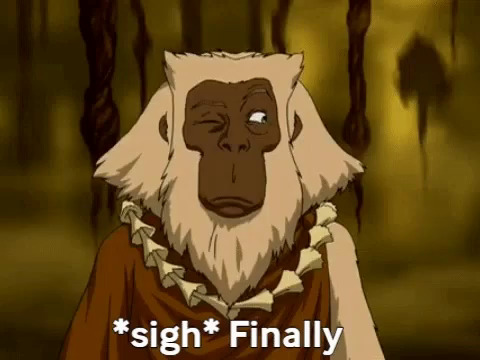
now what the fuck was this.
i mean i wouldn’t say this is the most egregious example of them making fun of brown people but lord why did this even need to be there? this random guy from the spirit world has an indian accent ? and is fervently chanting ‘om’ for some reason, and it’s clearly meant to be seen as comical. also portraying brown people as monkeys....... really.
2) combustion man/sparky sparky boom man
when rewatching ATLA in 2019 i actually had no idea that this was a thing, because the last time i had watched it was as a kid and i didn’t finish it.
so lord was i in for a surprise when i saw...

now... now what.
if you didn’t know, combustion man’s ‘third eye’ is designed to replicate the hindu god of destruction, lord shiva. right down to the vibhuti on his forehead (referring to the three line markings around the third eye).
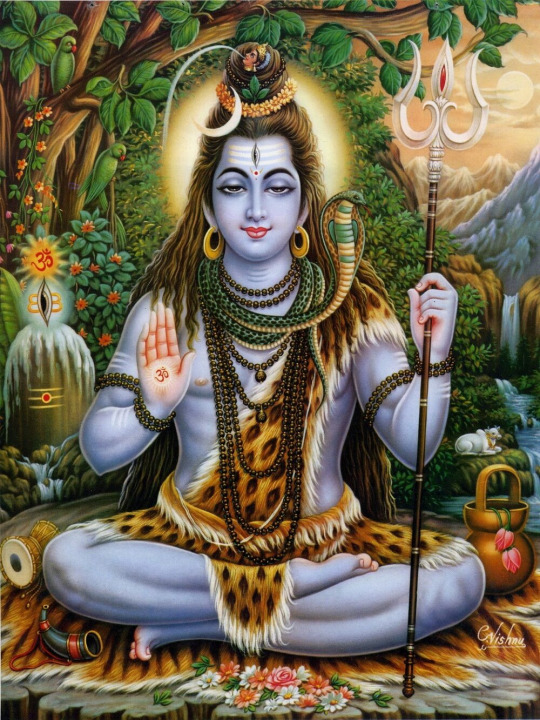
in hinduism, lord shiva’s third eye is used to reduce people to ashes, though as far as i can recall, not very frequently. the primary significance of the third eye is that it represents the ability of higher spiritual thought and higher consciousness.
the ATLA writers take the ACTUAL significance of the third eye, throw it out the window, and then take its destructive abilities to make a super duper cool and dangerous new firebending technique.
and if that wasn’t bad enough, the actual person who uses this technique, and is meant to emulate a GOD who is PRAISED, is a scary, burly, half metal man who is a villain and an assassin. not to mention the design of his facial hair replicates that super duper scary “terrorist” depiction of brown people, particularly of muslims, that white people are so thoroughly terrified of for no reason.
this is a parody of a god, and they portrayed him as this terrifying, maniacal fucking assassin who, along with p’li, the combustion bender from LOK, is constantly referred to as a “third-eyed freak”. i’ve made this analogy before and i’ll do it again, this is like making jesus into a hitman.
now onto my favorite example...
3) guru pathik
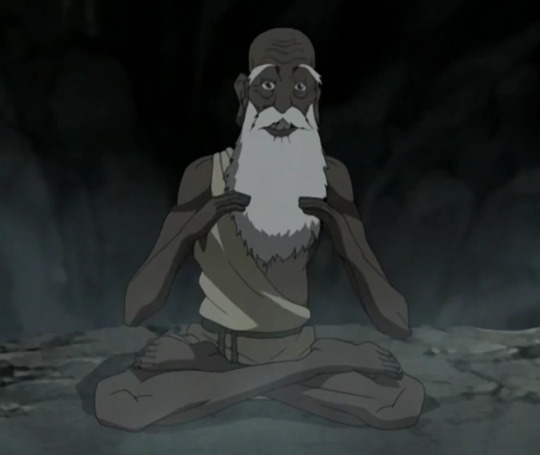
ah, this motherfucker.
i don’t really have any problems with him as a character, i mean hell, must’ve taken a fuck ton of patience to handle aang’s “why would choose cosmic energy over katara” bullshit.
but we all know it, we see it plain as day, don’t even try to deny it.
“guru” literally just means teacher or guide, so i don’t really know why pathik needed to be referred to as “guru” so distinctively from aang’s other teachers and guides, but that’s just extremely trivial compared to all the other issues with this character.
first of all what is this character design? what is he even wearing? if they’re trying to replicate the clothes of swamis and priests and stuff this is already wrong, realized people don’t dress like this. and why the fuck does he have an indian accent? and why was this indian accent done by a non indian (brian george)?
once again, the poor but extremely heavy indian accent is clearly meant to be mocking, if it wasn’t, they wouldn’t’ve gone out of their way to get a non indian person to DO an indian accent, and instead they would’ve just gotten an actual indian person to play the role.
and oh yeah, the onion and banana juice. because hindus just eat weird shit right.
whether it’s actually weird or not, the show certainly portrays it as weird. and as far as i know no hindu actually fucking drinks onion and banana juice.
ironic because brown people can absolutely destroy white people in cooking. but i digress.
i know what you’re all waiting for. because the guru apparently didn’t have enough fun with guru pathik, so they just had to come back to him in book 3:

where do i begin.
so this is obviously john o’bryan’s super funny and hilarious depiction of pathik as a hindu god.
usually when a god has multiple arms it’s to carry an array of things, from flowers to weapons to instruments, and one hand is typically free to bless devotees (ie. goddess durga and lord vishnu respectively):


but of course white people see this as weird and so they make fun of it, hence guru pathik having multiple arms just flailing about aimlessly (save for the two that are being used to carry the aforementioned onion and banana juice).
then there’s the whole light behind pathik’s head which is usually depicted in drawings of hindu gods to show that they are celestial.
also what the fuck is he holding? is that supposed to be a veena? because this is what a veena looks like:

and i assume the reason this was added was to mock the design of goddess saraswathi, who carries a veena:
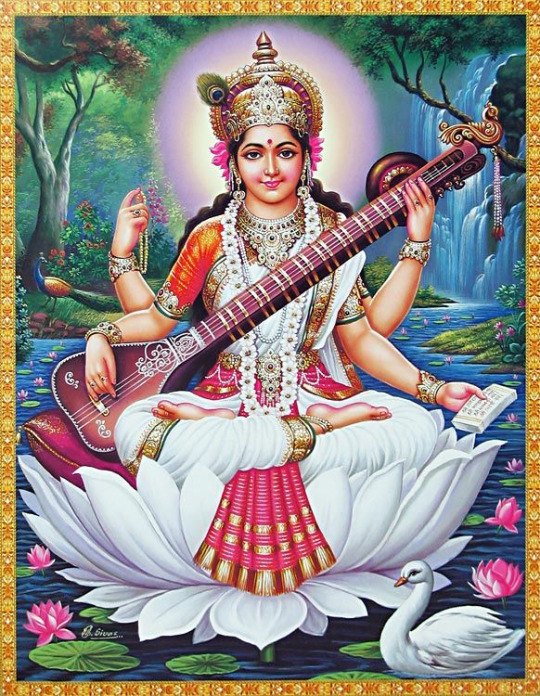
but that right there in the picture of pathik looks more like a tambura than a veena.

and it also just kinda looks like a banjo?
but i guess the animators just searched up “long indian instrument” and slapped it on there. actually no, that’s giving them too much credit, they probably didn’t search it up at all.
and then the actual scene is pathik singing crazily about chakras tasting good or something while playing the non-veena and it’s all supposed to be some funky crazy hallucination that aang is having due to sleep deprivation. just some crazy dream, just as crazy as talking appa and momo sparring with swords or tree-ozai coming to life.
our gurus and swamis and sadhus and generally realized people are very respected in hinduism, they’re people we look up to and honor very much. and our GODS are beings that we literally worship. and the writers just take both and make caricatures out of them for other white people to laugh at.
4) other shit
before we move to the next portion i just wanna mention there are also smaller backhanded jabs that i can’t really remember now, but one example was when zuko was all “we’ll be sure to remember that, guru goody goody”. or when a character would meditate and say “om” only when the meditation is supposed to be portrayed as comical or pointless. or in bitter work when sokka was rambling on about karma. small things like that. but moving on.
south asian representation, or lack thereof
now i finally get to the “losing” hinduism part. by this i mean the lack of actual representation there is of south asians (the region where hinduism is primarily practiced) despite the fact that hinduism plays such a big role in the show’s world design.
i think it’s safe to say that broadly the main cast consists of aang, katara, sokka, zuko, toph, azula, iroh, mai, ty lee, and suki.
a grand total of none of these characters are south asian. the writers don’t even attempt to add any south asian main characters.
there are characters with dark skin, like haru and jet, but a) they’re not confirmed to be south asian and don’t have any south asian features or south asian names, b) they’re side characters, so they don’t count as representation, and c) even if they were south asian and main characters, jet wouldn’t even count because he’s portrayed as a terrorist.
the ONLY truly south asian character we get is fucking guru pathik. so yeah. not representation.
i don’t get how the creators of this show rip off of hinduism (among many other south asian cultures they rip off of), mock indians, and then don’t even have the decency to HAVE a main character who is south asian.
i’ve never gotten a chance to compile all this, and this definitely isn’t all the creators have done, but i hope this was somewhat informative.
1K notes
·
View notes
Text
BAD BUDDY RERUN SEASON – EP.5 (NOTES ON THE REWATCH)
Slowly making my way along the ep-by-ep rewatch – part of why it takes so long is because I love rewatching bits over and over again! Anyway here are my notes on Ep.5 (links to notes on previous episodes are at listed the end of this write-up).
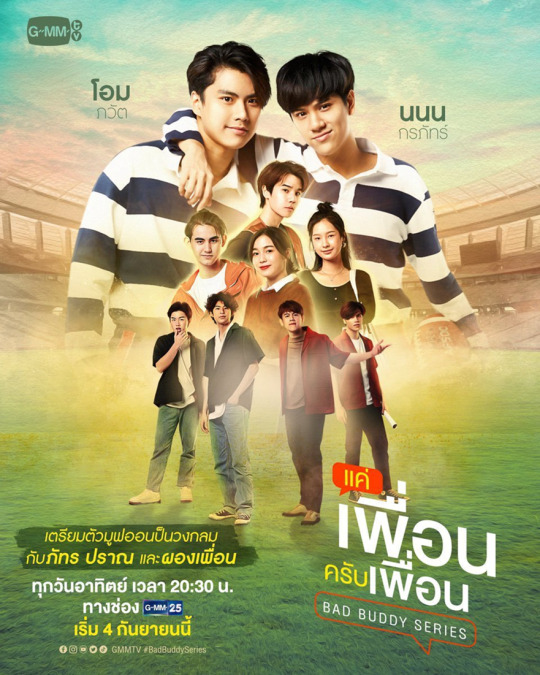
The opening scene of Ep.5 is one of my favorites and I have so much to say about it (because there's just so much happening in there). So much so that I've had to write it up separately – there's just too much information to combine it all with this essay. To read about the opening scene, see this link here.
So after the opening scene, Pat goes to look for Pran at his faculty, doing him a favor and handing him a thumb drive of files. This is of course a parallel with the scene in Ep.10 [1I4], when Pran summons Pat with a similar errand (delivering more files on a thumb drive), but in Ep.10 it's really an excuse to get him to their khan maak – and meta regarding significance of the khan maak scene is also buried within the details of the opening scene of Ep.5, when Pat is first assigned the task of extracting files from Pran's computer just before this (see link above).
But when Pat gets to Pran's faculty at Ep.5 [1I4] 6.39, in my mind the scene has also been set up to parallel another one (in Ep.9 [1I4], though it's not as important as the khan maak).
There are several signs pointing to this. When Pat walks through Pran's faculty, this is the one time in BBS when Rangsit University's College of Engineering stands in for Pran's Architecture Faculty building. Everywhere else, the role of SouthTechnology's Architecture Building is played by RSU's Architecture Building, readily identifiable by its use of charcoal gray walls.
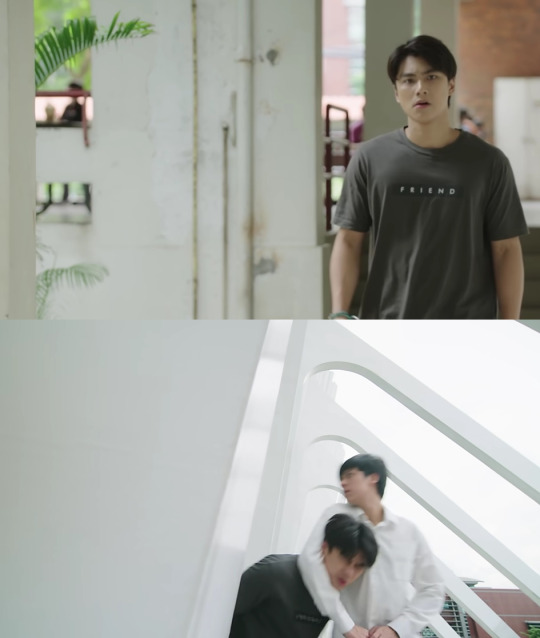
I'm thinking that RSU's white-walled College of Engineering was employed for this scene so that it would be visually less jarring when Pran drags Pat away, to end up at the white angled struts of a third building – actually RSU's Student Center (at Ep.5 [1I4] 7.35). But why go to all that trouble, just so that they could end up there?
There are two clues embedded in the proceedings. The first is Pat's "Boo!" at Ep.5 [1I4] 7.37, which is a set-up to draw attention to Ink's "Gotcha!" at Ep.5 [1I4] 7.58. The second clue is the way Ink's look has been styled when she surprises Pat and Pran in their "lovey-dovey" moment (her words).

Director Aof mentioned in one Soon Vijarn Reaction/Recap video that he was heavily involved in the art direction, and I don't think Ink's styling here is just random.
Ink's t-shirt looks quite shapeless and unisex, and is a departure from her usual style that sometimes incorporates a masculine touch but that also still projects femininity overall (e.g., small white men's shirts under large overshirts – see Ep.4 [1I4] 7.03 and Ep.7 [3I4] 3.16 – or men's knitted vests worn as blouses – see Ep.5 [2/4] 1.42 and Ep.10 [2/4] 5.16).
And apparently oversized t-shirts with contrasting horizontal stripes are a BL trope when worn by guys? 🤷♂️ Ink's top in this scene is reminiscent of Ayan's t-shirt when he dined with Akk's parents at the seaside in The Eclipse (although it's not the same cut or design).
In BBS it's definitely a look that's more identified with the male characters – the SouthTechnology rugby uniforms in Ep.9 [2/4] are one example. And Pran pays homage to this trope by wearing loose, long(ish)-sleeved/drop-shouldered t-shirts with horizontal stripes many times (e.g., at Ep.3 [4/4] 6.11, Ep.4 [1I4] 2.15, Ep.4 [1I4] 4.22, Ep.5 [2/4] 5.36, Ep.7 [2/4] 6.51, Ep.9 [1I4] 11.26, Ep.9 [4/4] 5.20, Ep.10 [3I4] 0.22, Ep.12 [1I4] 2.34).
It's not a look typically applied to Ink, Pa, or any of the other female characters (Pa does wear a top somewhat like this at Ep.10 [1I4] 17.09, but the contrast of horizontals is more muted). So Ink wearing this striped top really looks like a conspicuous deviation done on purpose (even though I think it is a women's t-shirt – see this link here).
But it's not just Ink's t-shirt that deviates. The biggest style divergence to me is in Ink's hairstyle –her hair's been done up with a distinctive topknot (and we don't see her wearing it this way anywhere else in BBS, at least not that I can recall – it comes closest in the poster for GMM25's rewatch though).
It's the topknot that is the biggest tell, in my opinion. In all of Bad Buddy, only one other person wears their hair consistently like this – and it's Pat's good buddy Korn.

So I think this scene – when Ink jumps out and surprises Pat and Pran – is a parallel to the scene in Ep.9 [1I4] 10.10 when Korn surprises Pat at these very same white angled struts of the RSU Student Center.
What they're trying to suggest here is that Ink is really just like Korn – someone who can never be anything more than a totally platonic friend to Pat. Her clothes and hairstyle are telling us she's not the girl Pat thinks she is – she's really just "one of the guys" here, so to speak (though I wish I could think of a less gendered phrase to use here – "one of the gang" maybe?).
This depiction of Ink also gets a reprise at Ep.5 [3I4] 12.28 when she places a sympathetic (but platonic) arm on Pat's pining shoulders at the Freshy Day Song Contest, while wearing a t-shirt that is almost exactly the same color as the one worn by another of Pat's buddies (Mo, who apparently likes that unusual shade of grape as much as she does).
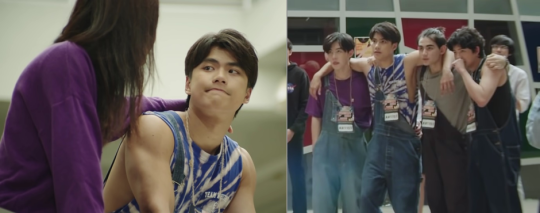
BBS is blurring the lines with Ink here, even while showing us that she is not at all the lazy BL stereotype of the scheming ex-girlfriend from the protagonist's past, who exists only to provide tension for the main couple's narrative. She's really a supportive buddy who deserves and gets her own fulfilling story arc too.
Of course Pran looks back at Ep.5 [1I4] 8.59 and sees the opposite of platonic InkPat. And ironically Pat will then actually go on to fall for one of the guys – but it's one who's totally outside his bro zone. 😊 This situation with Ink as Korn is BBS underlining what Pa says at Ep.5 [2/4] 0.55 – "Never date a friend. It won't work." Therefore Pat goes on to date his "enemy" instead (a bad buddy, not a good one – the quotation marks being of utmost importance here 💖).
So at the wonton noodle stall (Ep.5 [1I4] 9.28) – we see that Pat is perplexed when Ink's order is the same as Pran's favorite (egg noodles with three wontons). He seems a little cross even. On some level perhaps he's irked that the lines of emotional connection are getting entangled. But what it also shows is that he is ignorant of Ink's preference (haha) while Pran's is already known to him – by heart. 💖

Furthermore – the scene also contrasts with PatPran's Ep.12 scene at the noodle stall. What we are shown here at the Ep.5 table is that – insofar as being a partner for Pat (dining or otherwise) – Ink is quite the opposite of Pran. She compliments his table manners here, even though we go on to see that they never really improved – Pran still bugs him about his table manners in Ep.12. Three wontons might be the perfect number for Ink, but by Ep.12 Pran has learnt that his ideal order is four wontons not three (because Pat will steal one).
And in contrast to Pran giving up a wonton to Pat (in Ep.12) – we see Ink stealing one from Pat's bowl instead and not letting him take any from hers (Ep.5 [1I4] 10.39). In the world of Thai BL where food = love is a trope, Ink is receiving from Pat, but not offering in return – quite the reverse of Pran, who in Ep.12 returns Pat's love by ordering extra to give to him.
Looking again at PatPran's wonton noodle battle in Ep.3 – Pat takes a wonton from Pran, but he also returns it later (and this illustrates how there is love from Pran being sent in Pat's direction, and Pat eventually returns his love too).
So in the scene at the pancake café – Ink does go "Feed me" at Ep.5 [2/4] 4.05, but of course she says it to Pa instead (also echoed at Ep.12 [4/4] 0.38). And she then returns the love at Ep.5 [2/4] 5.09 when she offers a spoonful back.
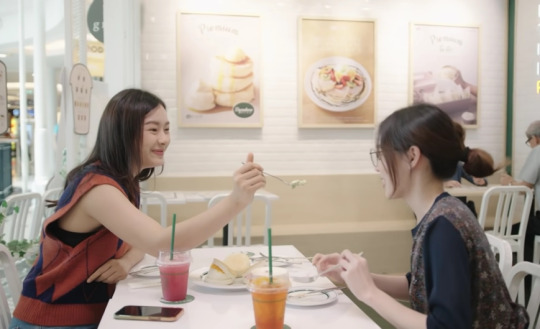
At Ep.5 [2/4] 0.32, when Pat says "I can sense it" I think we can all agree that he was sensing the stirrings of his heart for Pran, but misinterpreting them and mixing them up with his feelings of friendship for Ink instead.
But actually it looks like Pa is very much like Pat too – she's egging him on to date Ink and saying things like "Never date a friend… But if that friend is Ink, you have my greenlight" (Ep.5 [2/4] 0.55), "Let's do it!" (Ep.5 [2/4] 1.06) and "I like her. That's all" (Ep.5 [2/4] 1.09. Her proposal for Pat's date with Ink somehow includes her, as though it's normal for a guy's little sister to tag along 🤷♂️ (Ep.5 [2/4] 1.34). Pa is throwing herself into the mix with Ink and Pat, and on the rewatch we can now see that she herself is really into Ink, but isn't aware of it (just like her brother with Pran).
So when Pat's assignation with Ink at the Gram pancake café goes all awry, he's more than happy to leave Ink with Pa even though neither he nor Pa realize that it's actually he who's the extraneous third wheel on that date.
The first few times I watched Pat taking refuge in the music shop, it was hard to look past the bloopers though. When Pat and Pran reach for a guitar at the same time, whose hand is on top switches places in consecutive shots.
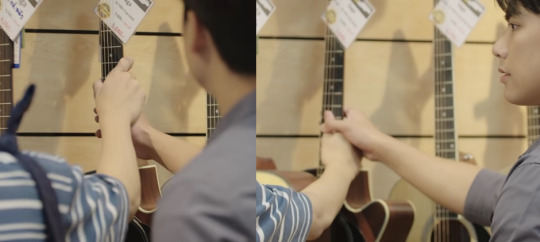
And given the open layout of the shop they must have seen each other before that happened (even if Pat were somewhat lost in his thoughts), so both of them darting out simultaneously for the guitar like that doesn't seem natural. It also doesn't read too convincingly to me that Pran is so standoffish (even if the guitars do provoke an uncontrollable fascination in him – we know that he was never blind to Pat's charms, and should have acknowledged his presence earlier).
But I think the hands on the guitar together is significant, in more ways than one – it's more than just a set-up to show how Pran's touch triggers Pat's awakening in the light of Pa's love guru dictum.
We know from Ep.3 [3I4] 2.20 that Pat doesn't play guitar. The guitar is Pran's thing – Pat knows this and identifies the instrument with Pran because he salvaged and kept Pran's guitar all those years ago. And looking at Pran's relationship with his guitar throughout BBS, but especially in Episodes 11 and 12, we can see that it is also a metaphor for his heart (while his relationship with his guitar and music also a metaphor for the LGBTQ+ experience growing up; see this write-up here for more explanation).
When Pat says "I wish I could play" in Ep.3 [3I4] – this shows more of his longing for Pran's heart, rather than just him wanting to take up another musical instrument. And when Pat reaches for the guitar he's actually reaching for Pran in his mind.
One of the themes in BBS that is shown to us (but is also underdeveloped I think) is how music binds Pat and Pran together. If Pran's guitar symbolizes his musical soul, on the rewatch I think it's possible to uncover a reading where Pat gets an equivalent metaphor too.
Way back at Ep.1 [1I4] 4.34 we saw Pat drumming happily in his room while pre-separation Pran was still in his life.
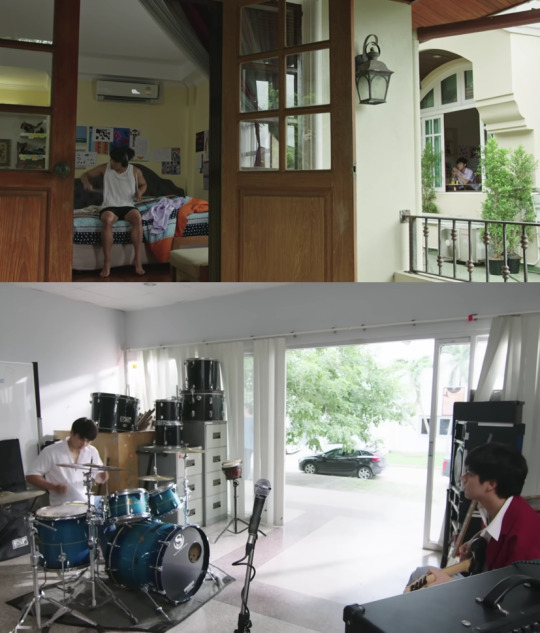
And when they re-established contact after Pran's exile, one of the first things they did together was jam in the music room at Ep.1 [2/4] 9.20, with Pat on the drums and Pran on guitar. Taking another look at that scene – while their previous encounter at the dustbins was fractious and confrontational, in the music room it looks like they're having a conversation and communicating. It's not the most beautiful dialogue, but they're talking with each other, while still maintaining their comforting competitive dynamic.
At Ep.6 [1I4] 10.06 Pat drums in frustration across their balconies trying to reach a closed-off Pran, while Pran making music on his guitar calls him over in Ep.12 [4/4] 9.15.
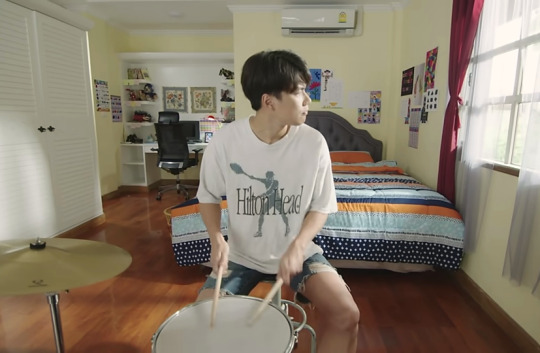
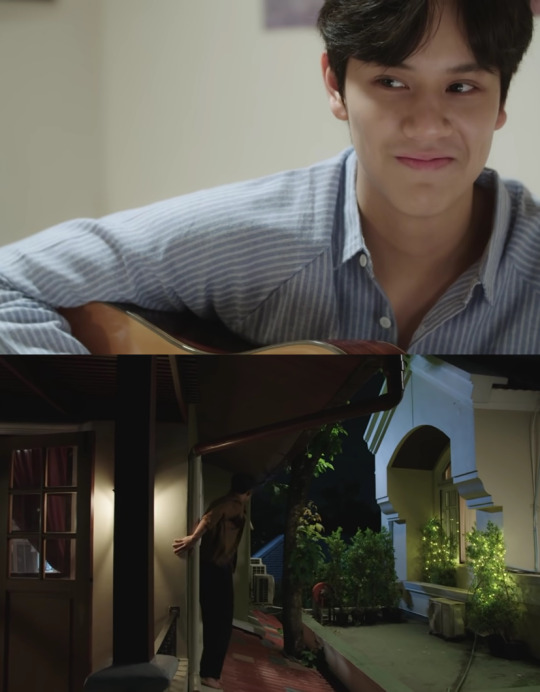
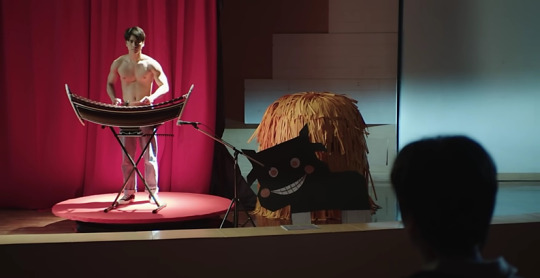
And Pat playing the ranat ek in Ep.8 [4/4] is able to call Pran back to him after their backstage argument through the power of emoting wordlessly through music alone. Pat playing the drums and the ranat ek is like Pran on his guitar – these are ways for them to express their inner selves and their truest emotions to each other.
But one feature of the drums and the ranat ek is that you can't just pick them up and play them like you can with a guitar. You need accessories to do so; without the right mallets for the ranat ek and drumsticks for the drums, they are unable to communicate their musicality to the audience.
The parallel for Pat is that he needs the right tools in order for the drumming of his emotions to be heard accurately and correctly.
It's significant that in Ep.4 [2/4] Pa had to deliver Pat's contact lenses to him at the photoshoot, blessing him with the gift of clearsightedness with regard to Ink and her camera (a metaphor for Ink and her romantic focus). This was BBS foreshadowing Pa delivering Pat's ranat ek mallets to him at Ep.7 [3I4] 1.38, and also why she says "Use a delivery service" at Ep.5 [2/4] 4.42 – it's a call-out to these instances when she delivers what Pat needs in order to connect correctly with (and also articulate) what he's feeling inside.
Just like the contact lenses clarified his vision at the photoshoot, and the ranat ek mallets helped Pat call Pran back to him after their argument behind the backdrop in Ep.8 [4/4], it was Pa's love guru advice that enabled Pat to recognize his love for Pran and eventually reach out with it.
So the drumsticks in the music shop are more than just an excuse to get Pat and Pran in the same locale for his romantic awakening. They actually symbolize Pat's experience in unlocking the communication of his true feelings, which is also why he's clutching those drumsticks so tightly as his long-buried but always abiding love for Pran finally bubbles up into his consciousness.
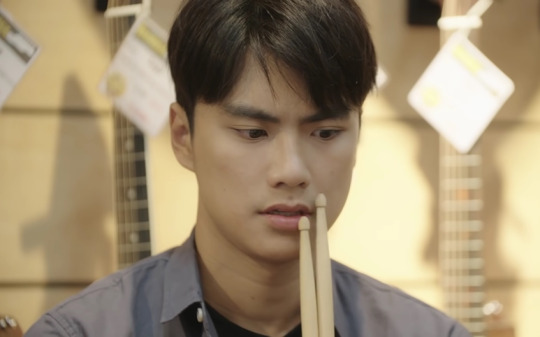
Anyway, when Pran tosses out a "Are you trying to bug me?" at Ep.5 [2/4] 7.44, he's fully expecting Pat to fall back into their game of sniping at each other again. But Pat then lives out the fourth bit of Pa's love mantras – "People who like you can’t be themselves around you" – and storms out all flustered instead. This is why Pran looks so confused at Ep.5 [2/4] 8.02, because Pat here is not the cheerfully competitive and engaging sunshine boy whom he knows so well.
The next two scenes that close off Ep.5 [2/4] show Pat coming to the realization that he's really in love with Pran (getting jealous over Wai's phone call and closeness with Pran's family), even as Pran paradoxically spirals further in the other direction, firmly believing that Ink and Pat are a couple now (when he recalls seeing them on their pancake date and crosses out all hope of Pat loving him back).
So Ep.5 [3I4] starts off with a scene showing Pat swirling and sinking ever deeper into his realization about his love for Pran, with the flashback to their songwriting process in high school.

Some minor observations on the flashback:
Both Ohm and Nanon are tall (6'1" and 6' respectively) and the production has been really smart when setting them up for their high school portrayals – the flashback scene is a good example. Their uniforms are always oversized so that the boys still look gangly and growing into them, with the short sleeves almost reaching their elbows. But it's also in the way they hold themselves too – Nanon is hunched over his guitar, and Ohm leans forward toward the camera. Their postures both work to foreshorten their tallness and at no point do they look like anything but teen schoolboys.
Pran was already deep in his crush for Pat here, and was feeling inspired to write a song describing their relationship, but doesn't tell Pat directly. The scene shows us that Pat still sees the connection, and jumps on it by saying "This is exactly our houses’ situation!" at Ep.5 [3I4] 1.32. But it also shows us clueless Pat ignoring (and maybe subconsciously accepting) the first part of what Pran said: "I'd like to compose something that conveys the sense of ‘born to be together’" (Ep.5 [3I4] 0.54), which is an echo of Pa's "I call this 'soulmates'" at Ep.1 [2/4] 2.40. It seems that Pat on some level knows that the two of them are deeply connected in a way that possibly transcends time.
When Pran says "born to be together", the background music that immediately starts is similar (though not the same) as that which plays behind their cross-balcony tin-can telephone scene at Ep.12 [4/4] 13.43, which shows PatPran closely bonded both as adults and as kids. Both are tinkling, unaccompanied piano motifs that emphasize the first three notes and dominant fifth note of the scale; in Ep.5 the motifs repeatedly descend while in Ep.12 the direction is upwards and uplifting. In connecting this scene with that one musically, it shows that their bond was maintained even in high school before Pran was sent away, and suggests a certain continuity and perhaps unbreakability too. As the scene is a flashback, we see Pat mulling over the significance of this bond and also the meaning behind what Pran was saying over his guitar all those years ago.
If Pran's totem is his guitar, and Pat's totem is his drumsticks – both are present in this scene (the drumsticks are on the picnic table), and suggest that the boys are speaking emotional truths from the heart to each other. Maybe this is why Pat signs off his name with a heart as well (see Ep.5 [3I4] 2.59), symbolizing his yet unrecognized love for Pran, and demands a half share (showing his emotional investment in the song, that he will only realize later and acknowledge on the rooftop in Ep.5 [4/4]).

Pat spells his name with an "h" after the "P" (Ep.5 [3I4] 2.58) and this is not technically wrong. The "P" in Pat's name is aspirated (with a puff of air, kind of like the way the British, Australians, Kiwis and South Africans pronounce the letter "p" when speaking English), and the spelling in his signature is in line with the Royal Thai General System of Transcription (RTGS) where an aspirated "p" sound is spelt "ph". The "P" in Pran's name is non-aspirated, and is closer to the way the letter "p" is pronounced in Malay/Indonesian, Tamil, Tagalog, French, Spanish and Italian (also corresponding to the sound of the letter "b" in hanyu pinyin). I suppose the production eventually went with spelling Pat's name minus the "h" to avoid it being pronounced like "Fat" (which is how "Phat" looks like it should be pronounced, to any monolingual English speakers).
When Pran displays a fascination for the words "wan wan" (หวั่น หวั่น) at Ep.5 [3I4] 2.03, he's actually describing his state of mind during his ongoing crush for Pat (see this write-up here for more explanation).
In response to Pat acknowledging that Ink sent zero romantic signals to him, of course Pa says "I would go on if I were you" – because if she were in his place her love guru advice would show results.
But when she tells Pat he should continue to court Ink, BBS plays with the food = love trope yet again. He doesn't say outright that he won't court Ink, but he refuses Pa's offer of khanom jeep (and we know by now that jeep is a homograph that can also mean "to court", besides referring to the Thai version of shaomai dumplings as well).
When she forces one on him, he takes it reluctantly but doesn't swallow, munching out his feelings pitifully (in an unconscious parallel with the way Pran was munching emotionally on plain bread at Ep.5 [2/4] 10.02) as he pines for his soulmate while trying to decode Pran's lyrics to the song they wrote together in high school.

Backstage before the Freshy Day Song Contest, we see that Pran is firm in his belief that InkPat are a couple when he says to Pat "Where is Ink?... She should be here supporting you" (Ep.5 [3I4] 5.50). This is BBS setting things up for Pran's retreat after their kiss on the rooftop at the end of Ep.5 [4/4]. And when Wai breaks up the conversation shortly after, the scene is also being set for the seeds of Pat's jealousy to grow before it erupts fully in the fight at the base of their student apartment building, also in Ep.5 [4/4].
When Pran begins singing though, the shared bond that he and Pat have over music finally breaks through and communicates with Pat what he'd been so blind to for so long, and that he'd only recently begun suspecting – that Pran actually loves him back. (For more info, Pat's POV is written up here.)

And then we see that any closeness that Pran demonstrates with Wai from this point on really begins to fan the flames of Pat's romantic envy (e.g., at Ep.5 [3I4] 13.40). Wai's gloating in the Flagpole Bar later just fuels this further.
So this episode just keeps hitting harder and heavier after starting out so light-hearted, until all the emotional pressure explodes in the conflagration between Pat, Pran and Wai beginning at Ep.5 [4/4] 2.21 – with drunken Pat's possessive yet needy "Come here" (มานี้ดิ, "ma ni di") to Pran.
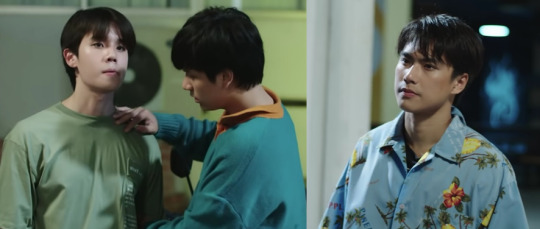
For a breakdown of that powerful scene, see this write-up here.
As the dramatic tensions fall away after the fight scene, with a montage of Pat coming to grips with its aftermath, we are led to the rooftop for what looks set to be a denouement of all the emotional entanglements that had come before. But Bad Buddy is not letting us off the hook so easily – just as Pat is thinking post-Kiss that he'd found the answers to all his questioning in this episode, Pran breaks away and raises even more questions about their relationship. (For an examination of Pran's motivations, see this write-up here.)

When Pran runs, BBS is setting up our two boys to embark on their real journey – and it's not to find the love between them (because it already exists). Pat and Pran's real voyage of discovery in BBS (insofar as their relationship is concerned) is how to establish the ground rules for their unconventional couplehood (because the normal rules don't apply), and then to find a way for that couplehood to survive in a world bent on extinguishing it.
But the first step of course is for Pat to convince overthinker Pran that their love isn't the doomed impossibility he thinks it is.
I'm resisting the temptation to go into detail about the whole scene on the rooftop, partly because I could write reams on it and this essay has gone on far too long as it is. But I'm also refraining because the scene was so powerful that it has been lodged indelibly in everyone's consciousness, and it was so raw and real it can stand on its own, and doesn't need any analysis for its strength to be conveyed. OhmNanon really gave it their all, and it shows.
But I will say this – remembering that PatPran's relationship is an allegory also for the LGBTQ+ experience of love (but with the animosity toward it based on reasons other than homophobia), Pat needing to change Pran's mind after The Kiss is Bad Buddy reminding us that in a world hostile to queer love, we need to start with ourselves first and counter any naysaying voices in our heads with the confidence that LGBTQ+ love can not only survive opposition to its being, but that it is also worthy of defending, and that we deserve to have it thriving in our lives. And only then do we embark on finding a way to live out that love on terms of our own making – not terms set by those around us who just want to tear it down.
[Afterpost Edit: for notes on the rewatch of other episodes, see these links here: Ep.1, Ep.2, Ep.3 and Ep.4. 😊]
13 notes
·
View notes
Text
Look, Louts! Lilies! - Yuri For A Hope-Flung Present and Hopeful Future
Look, I’ll be frank. I typically try to keep to a more formal tone when I write for this blog. I’m not in a formal mood. It is June October 2020, and I, like the rest of you, have been under quarantine for a little over three almost seven months now due to the Covid-19 virus. Throw in a eensy, teensy bit of massive political movements and change in response to police violence and racism, and an increase of police violence and racism in response to those movements, and I think it’s fair to say it’s been a tumultuous couple of months. Except, strangely, it also hasn’t been, because so much of this time has been characterized by ennui and isolation. Stressful, yet soul-numbing. In short, it’s been a very weird place to be in.
So, we’ve all found our different ways to cope. My sister’s way has been getting really into succulents(?), and my way has been buying digital manga and video games. I’ve finished stuff I’ve put off for literal years and bought stuff I had heard was good but wasn’t that hyped to get into. And somehow, the one thing I’ve really gotten into has been yuri?
Now, yuri has a very long and rich history, as well as its own sets of conventions and nuances, so it is with a great, great, GREAT deal of respect that I say that I’m going to simplify it for this essay as “Japanese media with a particular focus on romance between women” for brevity’s sake. If you want to know more, there’s actually quite a lot that’s been written about it in English, but I’m aiming this essay at English-speakers who have had at least a little experience with yuri and more than just passing knowledge.
Because you see, I’ve found that yuri fans have a lot of things to say about yuri! And a lot of those things really bug me!! “Yuri is only fetish quasi-porn written by men,” “yuri is only bland wholesome fluff,” “yuri is only high school drama,” so on, so on. It made me mad, but it also made me realize something: a lot of people simply must not know how big this field of lilies truly is! How else can we get people saying “yuri is oversexualized” and “yuri is sexless” as gospel truth? Something’s not adding up here, guys!
So, all that is to say I’m doing something different for this blog: I’m writing up a recommendation list of yuri. A large chunk of it will be stuff I’ve read and can officially give my seal of approval to, while some of them are just titles I’ve heard of that I think will interest others. All of them have been specifically chosen to counter common untrue things I’ve heard about yuri as a whole. I hope you can find at least a few things on this list that you will enjoy and help you keep your head as the encroaching darkness lurches yet a few inches closer!
1. “Yuri is all schoolgirl stuff! Where’s the sci-fi, the period pieces, the action, the fantasy?”

Otherside Picnic
What It Is: A light novel series written by Iori Miyazawa (illustrated by shirakaba). Ongoing, four volumes at time of writing. The story is being adapted into a manga by Eita Mizuno, and an anime adaptation directed by Takuya Satou will be airing in January 2021.
What It’s About: It was on her third trip to the Otherside that Sorawo Kamikoshi almost died, and it was on that same trip she was saved by an angel. Toriko Nishina is a beautiful and confident young woman who also happens to have intimate knowledge of the Otherside, a dangerous yet captivating world that Sorawo can’t help but being drawn to. Toriko convinces Sorawo to join her on her expeditions to the Otherside, fighting off bizarre creatures that have somehow been ripped out of Japanese urban legends and finding strange artifacts in order to make a little extra cash-- all the while keeping an eye out for someone dear to Toriko’s heart.
What I Think: Otherside Picnic is heavily inspired by the novel Roadside Picnic by Arkady and Boris Strugatsky and features several creatures and scenarios from ghost stories, net lore, and-- there’s no other way to put this-- creepypasta. On paper this sounds deeply unoriginal, so it’s pretty surprising that OP has an incredibly strong identity. The idea of fusing horror with a yuri love story excited me enough the moment I heard about it, so when I finally got to read it for myself, I was delighted to find that the horror elements and the romance elements are both quite strong.
I will say that thanks to the author’s commitment to following his sources of inspiration to the letter sometimes causes him to undercut his own writing (good example: in one arc there’s an ominous train that keeps being mentioned, causing the reader to dread its arrival with each passing page, but seeing what’s on the train will inevitably fall flat in comparison to the reader’s imagination), but those moments are made up by the more original moments-- the things that are left unseen and unexplained.
The place where the story truly shines is the relationship between the two leads. Sorawo and Toriko are great characters, both incredibly charming and deeply flawed, and they achieve a great chemistry with each other right off the bat. Sorawo is a very interesting protagonist, one who turns out to have a deeply tragic past that has made her into a reclusive, somewhat selfish young woman. What’s great is that Toriko, vivacious and confident, everything Sorawo isn’t, accepts this part of her, in a way. Toriko flat out admits she’s not looking for a particularly virtuous person to accompany her, but an “accomplice.” A big part of the appeal of OP is seeing these two “accomplices” bounce off each other, and eventually come to care about each other, all playing against a background of some genuinely spine-crawling horror. Otherside Picnic is a truly underrated series, and I deeply hope that the anime adaption next year will finally get it all the eyes it deserves (menacing phrasing very much intended).
Where To Get It: The light novels are published by J-Novel Club and can be found via various digital platforms and bookstores. The manga will be published by Square Enix Books starting May 2021. The anime will start airing on January 4th, 2021.
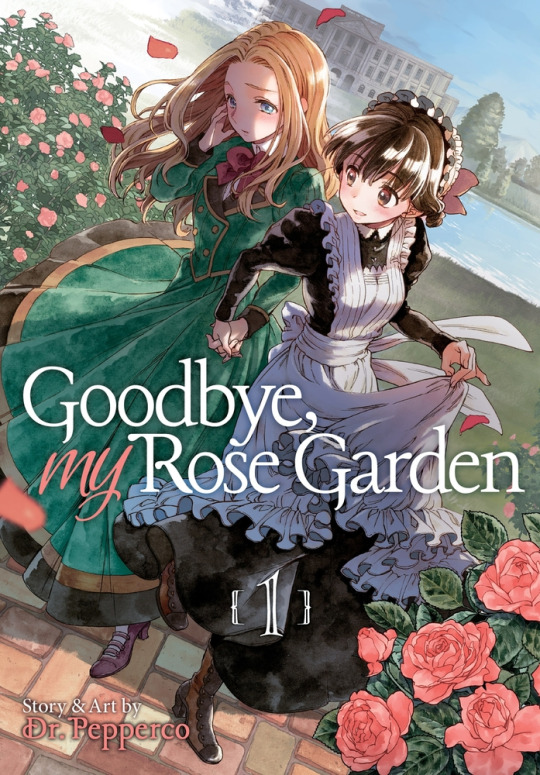
Goodbye My Rose Garden
What It Is: A manga by Dr. Pepperco. Three volumes, complete. It inspired a stage play that ran for a while in Japan, but not much information is available about it in English.
What It’s About: Hanako has two goals: to meet Victor Franks, the mysterious author who pens the books she adores, and to become a writer herself. Despite having the mettle to travel to England on her own to pursue her dreams, she soons finds that it’s difficult for a young, unwed Japanese woman to dream in 20th century London. However, her luck seems to turn around when she meets Alice Douglas, a noblewoman who offers her a job as her maid-- as well as a surprisingly warm friendship. Alice even offers Hanako a way to meet her idol… but at the price of a horrifying request.
What I Think: In the afterword of Volume 1, Dr. Pepperco openly admits that Goodbye, My Rose Garden was the result of them trying to marry all of their favorite tropes (“Victorian maids! Loads of frills! An English family manor!” are some standout items), and this is apparent in the best way possible. GMRG is a lush period piece that will likely appeal to fans of movies like The Handmaiden and Portrait Of A Lady On Fire, with loving attention paid to details like clothes and settings.
The relationship between Alice and Hanako is quite charming, with Alice supporting Hanako as much as she can while still taking every available opportunity to tease her, while Hanako constantly surprises Alice each time she shows her moxie and strength. It’s an adorable, sweet dynamic, yet a dark, melancholy weight lurks in the background in the form of Alice’s request-- in short, it’s a relationship that feels tailor made for me. Still, I believe this “darkness” never threatens to overwhelm the story, only enhance it in such a way that the reader will soldier on, hoping for a happy ending for our two leads. With an engaging plot and gorgeous art, this is a great manga for both longtime yuri fans and newcomers looking for an introduction to the world of yuri.
Where To Get It: Seven Seas Entertainment has translated the first two volumes, with the final one coming to English soon all three volumes into English.
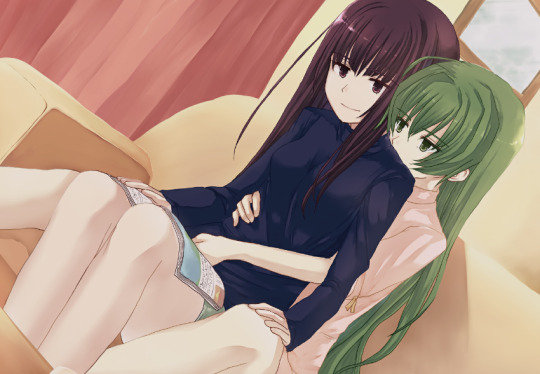
Seabed
What It Is: A visual novel by paleontology, a Japanese doujin circle.
What It’s About: Mizuno Sachiko is a designer who is haunted by visions of Takako, her vivacious childhood friend and former lover. Narasaki Hibiki is a psychiatrist who wants to help Sachiko make sense of these hallucinations. Takako is… confused, trying to figure out why she keeps losing her memory and why she and Sachiko drifted apart despite being so close. Seabed is a story that spans the pasts and presents of these three women as they attempt to find and understand the truth.
What I Think: At first glance, Seabed seems simple, but it’s a bit of a hard story to explain. In a way, there isn’t much to explain-- it’s a very slow, down-to-earth story that gets almost tedious at times. I think it would be a hard sell to someone who isn’t used to visual novels, but I could imagine it being challenging even for fans. All I’ll say is this: if you give Seabed a chance, it will draw you into a surreal, gentle, melancholy tale akin to slowly sinking beneath the water of a strange, yet not unfriendly sea. For its simplicity, it’s got quite a few surprises in its long, long runtime, and any attempt to explain further will just ruin an experience that’s meant to wash over the reader over time. The only thing I’ll say is the one thing I think everyone knows: the climax will make you cry.
Where To Get It: Seabed is published in English through Fruitbat Factory and is available on Steam, Itch.io, and Nintendo Switch.

SHWD
What It Is: A manga by Sono. Ongoing.
What It’s About: Sawada is one of the few women working for the Special Hazardous Waste Disposal, and the only one in her office. But that changes when the stunningly-strong yet staggeringly-sweet Koga is hired, and the two become close in no time. Sawada trains Koga and soon the two go on their first mission to dispose of the “hazardous waste” left after a recent war… the dangerous, organic anti-human weapons known as the Dynamis.
What I Think: SHWD opens with several close-ups of Sawada’s arm muscles as she works out. I have found that page alone is sometimes enough to convince someone to read SHWD, and if not, pictures of Sawada and-- especially-- Koga are often enough to do the job. In all seriousness, what I love about SHWD can be summarized by something Sono said in an interview about the manga:
‘The first motivating force was "I want to write a yuri manga featuring strong women." I was very drawn to strong female characters by watching "PERSON of INTEREST" and "Assassin's Creed Odyssey." However, I felt that I should differentiate myself by doing something other than a "strong woman" and "weak woman" dynamic. So, I thought about coupling women with different types of strength. This is why all of the SHWD main characters are "strong women."’
It’s a mindset I love a lot. Koga is remarkably strong in a physical sense, but her mental fortitude is fragile due to her past experiences with the Dynamis, and as such, it’s Sawada who uses her immense mental strength to support her. Indeed, every character in SHWD so far bears intense trauma born of the Dynamis in some way, and it’s hard to see how their pasts still hurt them in the present. But that just makes it satisfying to see these women come together to support one another. SHWD drew me in with a unique and often dark action-oriented story with horror elements, but it’s this idea of “strong women” who make up for each other’s weaknesses that really makes it dear to me.
Also, it can’t be stated enough that Sono is so so so so so (etc) good at drawing muscular women.
On a completely unrelated note, there’s a side story about Koga and Sawada playing sports together. This includes judo. I am saying this for no reason.
Where To Get It: The English translation of the manga is released in chapters by Lilyka Manga.
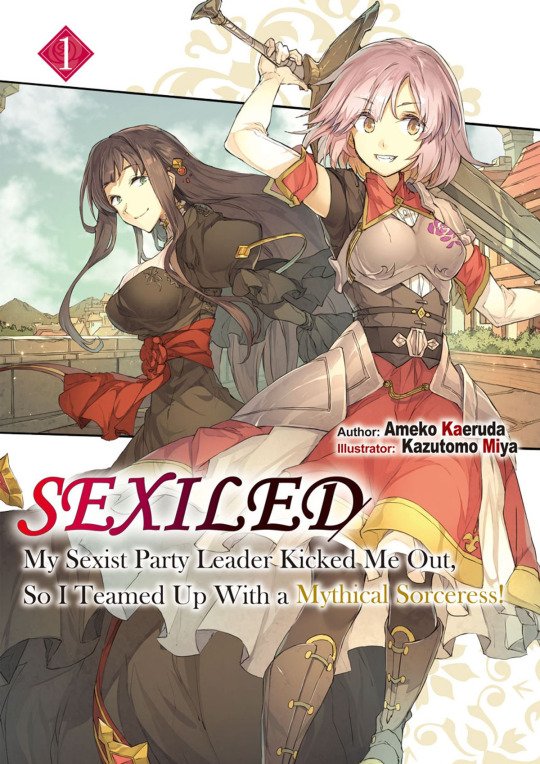
Sexiled: My Sexist Party Leader Kicked Me Out, So I Teamed Up With a Mythical Sorceress!
What It Is: A two volume light novel series by Ameko Kaeruda, illustrated by Kazutomo Miya. Possibly complete.
What It’s About: Tanya Artemiciov is an absurdly talented Mage. So why the hell was she kicked out of her adventuring party? Her leader and former friend sums it up in four words: “You’re a woman, Tanya.” In a fit of rage, Tanya channels her anger into a “venting” session that involves swearing her head of and casting a volley of Explosion spells into the wasteland… and accidentally releases a legendary sorceress! Luckily, Laplace is actually quite nice, and just as powerful as the legends say, so the two decide to team up so Tanya can have her revenge!
What I Think: So, this is a silly one, but after a couple of darker entries I think it’s a good palate cleanser. Sexiled is a loud, not-even-remotely subtle, unabashedly feminist take on the “power fantasy” light novel, especially the “revenge fantasy” subgenre-- and even if that sounds awesome on paper to you (ex. me), it will probably feel over-the-top at times to you (ex. me). But in a way, that’s actually kind of its charm.
I like that Kaeruda utterly refuses to let up on what she wants to tell you, especially because the story was inspired by a real case in Japan. One may be tempted to think “this story is ridiculous, no one would ever be this cartoonishly sexist!” and then you read a news article about how in a famous Japanese medical university was found rigging the test scores of women, and you realize, “oh, people are still this cartoonishly sexist.” So I’m fine with Kaeruda letting it all out in this story. At the same time, I think Sexiled is best when it’s focused not on Tanya’s revenge but on her kindness, and the way her compassion, her strength, and yes, her anger inspires the women and girls around her.

Sexiled is a fun and often very funny romp about assholes getting theirs, with some surprisingly deep and nuanced moments hiding in a very unsubtle story.
Where To Get It: The light novels are published by J-Novel Club and can be found via various digital platforms and bookstores.
BONUS: Other titles with sci-fi/fantasy/action elements that may interest you!
The Blank Of Describer: A one-shot manga by kkzt about a pair of two dream-builders. They’ve taken all kinds of commissions in the past, but one job they recieve throws them for a loop: a request for a shinigami that can predict and report death. And then comes the kicker: the customer asks the two of them to give it features that the both of them “adore the most…” (Published in English by Lilyka Manga)
A Lily Blooms In Another World: A light novel by Ameko Kaeruda (illustrated by Shio Sakura), author of Sexiled, about Miyako, a Japanese wage slave reincarnated into another world based on her favorite otome game. However, she’s not interested in her would-be love interest, but in Fuuka Hamilton-- the game’s villainess! After Miyako confesses her love, Fuuka decides to give her a challenge: if Miyako can make her say the words “I’m happy” in fourteen days, she’ll stay by her side! (Published in English through J-Novel Club, available on various platforms)
Superwomen In Love: An ongoing manga by sometime about the sentai villainess Honey Trap and her infatuation with the masked superheroine Rapid Rabbit. After being kicked out of her evil organization, Honey Trap decides to team up with her former nemesis to fight evil-- and hopefully, find romance! (To be published in English by Seven Seas Entertainment, coming in April 2021)
2. “Yuri is all stories about teenagers! Where’s the stuff about adults?”
Take a look at the previous section: there’s the stuff about adults! Otherside Picnic, Goodbye My Rose Garden, Seabed, SHWD, Sexiled, The Blank of Describer, A Lily Blooms In Another World, and Superwomen In Love are all stories with adult-aged protagonists! But if you’re searching for a more down-to-earth romance, I’m happy to report there’s quite a bit of options to look into!

Still Sick
What It Is: A manga by Akashi. Three volumes, complete.
What It’s About: Makoto Shimizu is an office lady with a secret: she’s a yuri fan who draws doujinshi. She’s able to keep her two lives separate, all until the day she comes face-to-face with her co-worker at a convention! To Makoto’s horror, Akane Maekawa is amused by her nerdy secret, but Akane may have some secrets of her own...
What I Think: This one was a roller coaster for me: I loved the premise of the manga, but wasn’t sure about the dynamic between the leads… that is, until near the end of the first volume, where something happened and everything changed. Without giving too much away, I implore people to give Still Sick a chance-- it has a much deeper story than one might initially guess, as well as an interesting character dynamic between the two leads with some surprising turns.
Where To Get It: The first two volumes of Still Sick are published in English by Tokyopop, with the final one coming soon All three volumes have been published in English by Tokyopop.

After Hours
What It Is: A manga by Yuhta Nishio. Three volumes, complete.
What It’s About: After being ditched by her friend at a club, Emi Ashiana is ready to write the whole night off. All that changes when she meets Kei, a DJ who seems to be everything Emi is not-- cool, confident… employed.... But Kei and Emi hit it off and Emi’s life changes as Kei draws her into the world of Japan’s club scene!
What I Think: It’s hard to explain exactly why I like this manga, but I reeeeally like this manga.
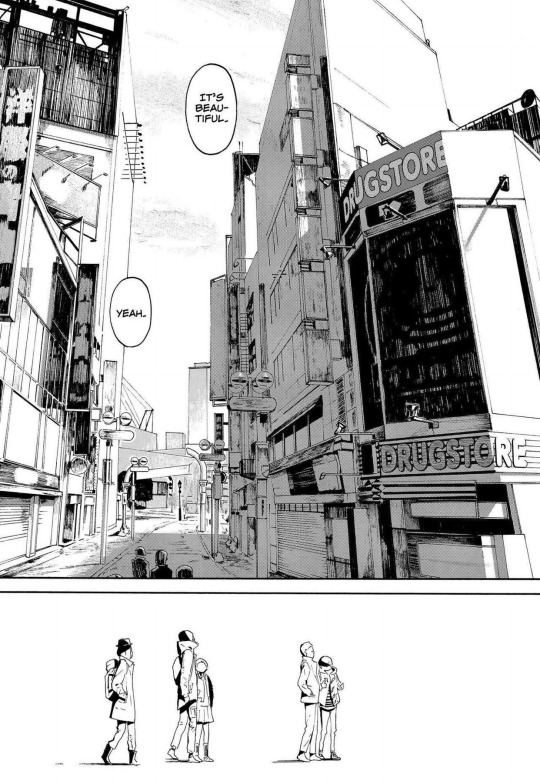
There’s just something about the sleek art, the amazing atmosphere of the scenes set in nightclubs, the chemistry between Emi and Kei, the focus on more mature topics.... it’s a manga that’s remarkably magnetic for how down-to-earth it is. It’s also just interesting to read stories about subcultures that don’t normally get a spotlight in comics. To sum it up, After Hours is just a lovely manga that’s severely underrated that’s perfect for someone who’s looking for a story that’s both fun and mature.
Where To Get It: All three volumes are published in English by Viz Media.
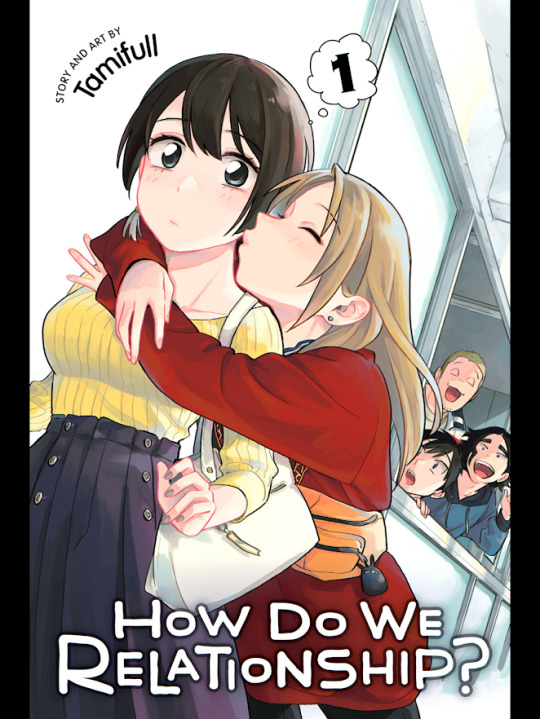
How Do We Relationship?
What It Is: A manga by Tamifull. Ongoing, five volumes at time of writing.
What It’s About: Miwa and Saeko’s first meeting is… interesting. But despite that, and despite their clashing personalities, the two of them become fast friends. Well… actually, perhaps more than friends. You see, pretty soon the two of them learn that the other is into women. With that in mind, Saeko suggests they try dating each other-- might as well, right? “Might as well” seems like a strange place to begin a relationship, but perhaps even something like that could end in true love?
What I Think: “Why do romances always end when they decide to start dating?!” That’s the question Tamifull poses in the afterword of Volume 1. And it’s a great question! What makes How Do We Relationship? an interesting manga is how oddly realistic it is, highlighting things like the compromises people make in relationships, people who get into relationships for pragmatic reasons rather than love, the whole “thing” about sex… as well as highlighting the additional issues queer people have to deal with. That may sound like a heavy story, but it’s actually quite light-hearted, as well as very, very funny at times. With a cute art style and surprisingly deep premise, HDWR is a great manga for older yuri fans who are craving a more mature story.
Where To Get It: The first volume has been published in English by Viz Media, with more on the way.
BONUS: Other titles with adult protagonists that may interest you!
Even Though We’re Adults: A manga by Takako Shimura about two women in their thirties. Ayano and Akari meet each other in a bar and almost immediately feel a sense of chemistry between them. There’s just one problem: Ayano is married to someone else. (To be published in English by Seven Seas Entertainment, coming in January 2021)
Doughnuts Under A Crescent Moon: A manga by Shio Usui. Uno Hinako wants nothing more than to be seen as a normal young woman, but she just can’t seem to make a “normal” romance work. But maybe Sato Asahi, a woman who works at the same company as her, can show her a new kind of normal? (To be published in English by Seven Seas Entertainment, coming in February 2021)
Our Teachers Are Dating: A manga by Pikachi Ohi. Hayama Asuka is a gym teacher, Terano Saki is a biology teacher. One day, they come into work both looking suspiciously happy… because they’ve started dating! (Published in English by Seven Seas Entertainment)
I Married My Best Friend To Shut My Parents Up: A one-volume manga by Kodama Naoko. Morimoto is sick and tired about constantly being badgered about finding a man to marry, so her kouhai from her high school days offers a solution: marry each other to make her parents back off! (Published in English by Seven Seas Entertainment)
Now Loading…!: A one-volume manga by Mikan Uji. Takagi has just snagged her dream job at a games publisher, but being put in charge of a mobile game that’s barely pulling in any attention isn’t exactly what she was hoping for. What’s worse, she’s drawn the attention of her strict higher-up Sakurazuki Kaori… who also happened to design her most favorite game of all time?! (Published in English through Seven Seas Entertainment)
3. “Yuri is all schoolgirl stuff! Where’s- wait, didn’t we already do this one?”
Yes we did. And you know what? I’m making a stand! There’s a lot of really, really good yuri stories set in high schools, and I think more people need to give them a chance! Here are some high school titles that I think are worth a second look for one reason or another!

Bloom Into You
What It Is: A manga by Nakatani Nio. Eight volumes, complete. A twelve episode anime aired in 2018, covering about the first half of the series. A three volume spinoff light novel series written by Hitoma Iruma was also published.
What It’s About: Yuu Koito has long dreamed of the day she’d find That One, Storybook Romance that would make her feel like she was walking on air, but the day that a boy confesses to her, her feet remain firmly planted on the ground. When she meets Touko Nanami, a girl who seems to have the same strange, distant relationship to romance as she does, Yuu feels like she has found a comrade. But what will happen when the next person to confess to Yuu… is Touko?
What I Think: What can I say about Bloom Into You that hasn’t already been said? There’s a reason it’s basically considered a staple of yuri despite being only five years old. The art is beautiful and delicate, the story has a deft mastery of comedy, drama, and romance, and the characters are deeply loveable. Really, the only reason this one is here is to tell you to get to reading this manga (or watching the anime) if you haven’t already. So get to it!
Where To Get It: The entire series-- as well as the spinoff light novel series Regarding Saeki Sayaka-- has been published in English by Seven Seas Entertainment. The anime is currently streaming on HiDive.
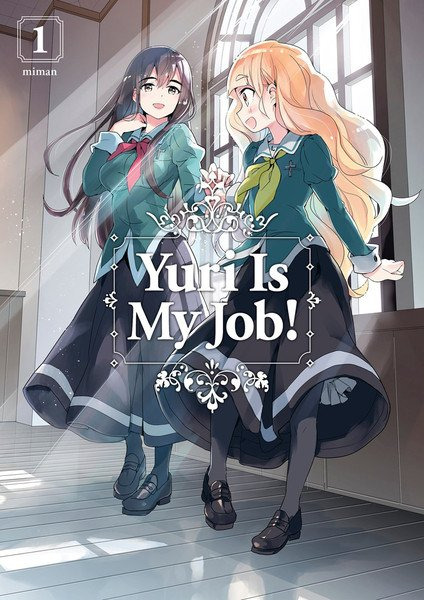
Yuri Is My Job
What It Is: A manga by Miman. Ongoing, seven volumes at time of writing.
What It’s About: Hime wants nothing more than to be adored by everyone and to someday bag a rich husband. Of course, being loved by all takes a lot of work, and she prides herself in keeping her perfect, adorable facade so well-maintained. But of course, the one time she slips up, she ends up injuring the manager of a local cafe! Hime finds herself strong-armed into working for this cafe under their star employee, a kind, graceful girl named Mitsuki. But things aren’t quite so simple-- you see, this cafe has a gimmick in which all the employees are constantly acting out yuri-inspired scenes for the customers, so in a way, the employees also have their own facades. And under her facade, Mitsuki… hates Hime’s guts!
What I Think: Yuri Is My Job is an odd duck, but in a good way. It’s advertised and initially framed as a comedy, but it becomes a surprisingly thoughtful drama about the personas people adopt and why they do so (though, luckily, the comedy never truly goes away). There’s an interesting web of relationships between the girls, and having those interactions take place in a setting where they must act out a completely different sort of drama adds an extra level of drama and intrigue. The cute, polished artwork is just the icing on the cake. YIMJ is a good manga for those who are already familiar with yuri tropes and those who are interested in a drama that doesn’t get too heavy.
Where To Get It: Six volumes have been published in English by Kodansha comics, with the seventh on the way.
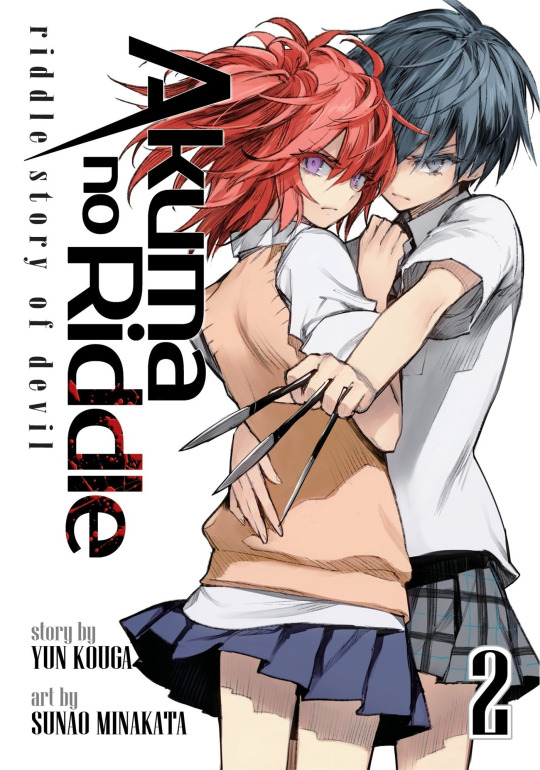
Riddle Story of Devil
What It Is: A manga written by Yun Kouga and illustrated by Sunao Minakata. Five volumes, complete. A 12 episode anime aired in 2014.
What It’s About: At Myojo Private School, an elite all-girl’s academy, Class Black has a secret. Twelve of the thirteen girls are actually assassins who have been offered a dark deal-- one wish will be granted to whoever manages to kill Haru Ichinose, the thirteenth student. But there’s still hope for Haru in the form of Tokaku Azuma, one of the assassins who has decided to defect to Haru’s side-- and defend her from the other girls at any cost.
What I Think: I’m not sure… if I can say Riddle Story of Devil is “good.” It’s definitely something. Although its premise is vaguely similar to Revolutionary Girl Utena, its tone and atmosphere remind me a lot more of the Dangan Ronpa series. It’s schlocky and ridiculous and often over-the-top and at times exploitative. It’s pure junk food, basically… and I believe that’s where the charm comes from. It’s my guiltiest of guilty pleasures. It may not exactly be good, but more often than not, it’s fun. It’s hard not to be immediately interested in a yuri battle series, you have to admit.
And if it does have one undeniably good element, it’s Tokaku and Haru’s relationship. They contrast each other nicely, and while one might expect Haru to be boring and helpless, she’s actually quite proactive at times, and some of the most interesting, engaging parts of the series come from seeing how the two work together to fend off the latest assassin. It’s a short read and if anything, it’s worth it to see how each girl ends up. I recommend it for older viewers who are okay with violence and ludicrous battle scenarios.
Where To Get It: All five volumes are available through Seven Seas Entertainment. The anime can be watched through Funimation.*
*Please don’t watch the anime.**
** At the very least, please don’t watch the anime unless you’ve read the entire manga. Riddle Story Of Devil was one of those unfortunate cases where the anime adaption was produced before the manga reached its conclusion, and as such it has a very strange, rushed ending that includes none of what I enjoyed about the actual ending. Several scenes were also changed, and if I recall correctly, fanservice was added in several places where there was none previously. All in all, I’d really only recommend it for big fans of the series.

Side By Side Dreamers
What It Is: A light novel by Iori Miyazawa, illustrated by Akane Malbeni. One volume, complete.
What It’s About: Saya Hokage has been suffering from insomnia, but one day finds relief in the form of Hitsuji Konparu, a strange girl who can put people to sleep. As it turns out, Hitsuji is a person who has the special ability to move freely in their dreams, known as a “Sleepwalker.” The Sleepwalkers have been battling beings that possess people through their dreams, and it turns out they want Saya to join them in the fight.
What I Think: Side By Side Dreamers is short and… well, dreamy. I really enjoyed the premise and I think it’s a good novel for people who think Otherside Picnic may be a little too much for them. I also enjoyed each dream sequence-- I tend to find that the writing in light novels is a little dry, so the use of figurative language to describe these scenes was really refreshing and interesting. SBSD is a fun oneshot that I think is especially ideal for newcomers to yuri.
Where To Get It: Side-by-Side Dreamers is published by J-Novel Club and can be found via various digital platforms and bookstores.
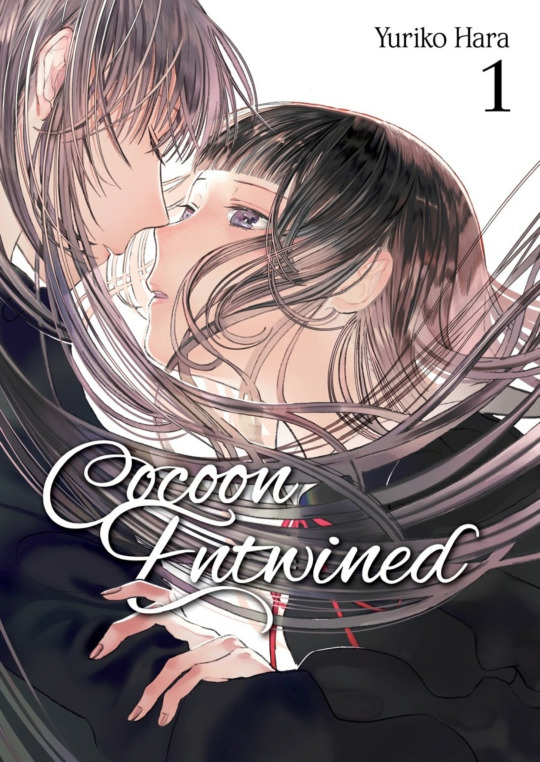
Cocoon Entwined
What It Is: A manga by Yuriko Hara. Three volumes, ongoing.
What It’s About: Hoshimiya Girls' Academy is a strange, almost otherworldly paradise with a peculiar tradition. For all three years, each girl grows out her hair to absurd, breathtaking lengths, in order for it to eventually be cut and weaved into uniforms for future students. Perhaps it is these strange uniforms that seem to whisper about the past that makes the school seem frozen in another time… picturesque, yet stagnant. But one day, a shocking incident shatters the quiet peace of the academy, and the tumultuous feelings that have long been hidden in the hearts of these girls come rushing into the light.
What I Think: Cocoon Entwined is, in a word, eerie. It’s not marketed as a horror story, and I don’t think it’s intended to be one, but I’ve seen some that say they get horror vibes from it. I definitely understand that-- there’s a deep sense of unease that permeates the entire story in a way that’s a bit hard to articulate. The running thread of uniforms made from human hair definitely doesn’t hurt (it does-- I’ve seen many people understandably turned off by this element), but it’s more than that. It’s the sense that everything at Hoshimiya feels frozen and fragile. It’s the sense that everyone is burying their true feelings under countless layers. It’s the fact that in one scene, Saeki reaches out in a dark room full of uniforms and feels her arm touched by countless hands made of hair.

Cocoon Entwined is a strange manga, and I feel it’s not for everyone-- besides the way many are put off by the central premise, the way that the story jumps around in time can be a bit confusing to follow. But in my opinion, I love it for these elements: the uniforms and their marriage between beauty and grotesque, the sense of frozen time, the delicate artwork that feels like it might be shattered by the weight of your gaze, the strange, airless atmosphere, the girls and their clear exhaustion of having to be ideal women. It’s a strange little series that I think should be given a shot, particularly if you want something a little more out there, or a darker take on Class S tropes.
Where To Get It: Yen Press has currently published two volumes in English.
BONUS: Other high school titles that may interest you!
A Tropical Fish Yearns For Snow: A manga by Makoto Hagino. Konatsu Amano has just moved to a new town by the sea, and must deal with her new school’s mandatory club policy. Luckily, she meets Koyuki Honami, an older girl who runs the Aquarium Club. Recognizing her loneliness, Konatsu decides to join her club. (Published in English by Viz Media)
Flowers: A four-part series of visual novels published by Innocent Grey. Flowers focuses on Saint Angraecum Academy, a private high school that prides itself on overseeing the growth of proper young ladies. One notable thing about the academy is the Amitié program, a system that pairs students together in order to foster friendships between the girls. But friendship isn’t the only thing blooming… (Available in English from Steam, J-List, and JAST USA)
Adachi And Shimamura: A series of light novels written by Hitoma Iruma and illustrated by Non that has recently received a manga adaptation and an anime adaption. Adachi and Shimamura are two girls who encounter each other one day while cutting class. Little by little, the two girls become a part of each other’s lives, and feelings begin to form. (The light novels are published in English by Seven Seas Entertainment, the anime is licensed by Funimation)
And there we go! 24 different yuri titles. I didn’t even go into the series that I tried but personally didn’t like that still might interest other people. I primarily made this list to gush about yuri that I liked, but I also tried to include a fairly wide range of things so that, hopefully, any random person who read this whole list could find at least one new title that interests them. And I hope that includes you!
The yuri scene is quite large and wonderful if you know where to look, and it too often gets a bad rap. I hope that this list could give you a new perspective on what kinds of titles are available, and I hope it gives you something new to try. And remember: if you want something specific, try looking for it! There’s a good chance the story you’re craving is already out there, waiting to be discovered!
#otherside picnic#shwd#goodbye my rose garden#sexiled#seabed#a lily blooms in another world#superwomen in love#the blank of describer#even though we're adults#doughnuts under a crescent moon#how do we relationship#still sick#bloom into you#yuri is my job#riddle story of devil#our teachers are dating!#yuri#cocoon entwined#wwydd#side by side dreamers#a tropical fish dreams of snow#now loading...!#i married my best friend to shut my parents up#adachi and shimamura#after hours#flowers#wwydd?
529 notes
·
View notes
Photo
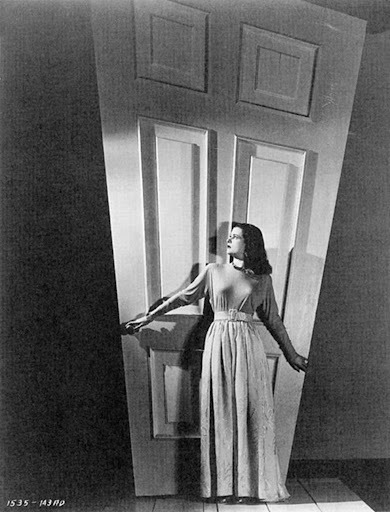
Joan Bennett in the film Secret Behind the Door
Sexuality and Space edited by Beatriz Colomina
Elizabeth Wilson
In the early 1990s the addition of “sexuality” seemed to take the vibrant debate on space into new territory. The very title of Sexuality and Space reflects this, and as Beatriz Colomina remarks in her brief introduction to the collection of articles it comprises, to insist on “sexuality” as a component of space can be, at one level, to insert feminist concerns into a masculine discourse—although it is dispiriting if sexuality is still perceived as women’s domain, somehow suggesting that anatomy still is destiny and/or that women are still equated with the bodily in a way that men are not. As Colomina makes clear, however, the volume, like the symposium at which the papers it contains were initially presented, aims to do more than simply “include women.” Nor does it aim simply to explore “how sexuality acts itself out in space,” although this would have been an interesting subject in its own right: how actually existing urban, architectural spaces are used intentionally or illicitly for sexual purposes. We could have had papers on the role of the “cottage” (public lavatory) in gay sex, on museums as pick-up grounds for intellectual singles, on the voyeurism of peep shows, and so on. But this would presumably have been too literal a project for the theorists gathered. Instead we are invited to treat architecture as a “system of representation” on a par with film and TV, and to ask how space is “already inscribed in the question of sexuality.” Gender is inscribed in space and space is never designed in a gender-neutral way.
Accordingly, the articles range across the visual arts in a fashion that at first glance seems not so much interdisciplinary as wildly eclectic—Atget photographs of Paris, Alberti’s writings, an Australian advertisement for real estate. The approaches taken by the authors are also widely divergent.
Jennifer Bloomer has missed an opportunity to explore the purported “effeminacy” of Louis Henri Sullivan’s architectural work. She raises the interesting issue of the assumed relationship between gender identity (and/or sexual orientation) and allegedly “feminine” architectural forms and decoration, but instead of developing this theme she flirts with it, creating a theoretical bricolage that fails to achieve intellectual coherence, her discussion of the function and symbolic importance of ornament not fully meshing with the problematic figure of Sullivan. A similar collagist approach is used by Catherine Ingraham, and I can see that it may be a kind of postmodern criticism; but while it permits the introduction of a variety of interesting, if only tenuously related, points and theories, it has a modish feel, especially when the usual theoretical suspects are rounded up for an airing, Lacan’s lavatory doors making repeat appearances. By contrast, Alessandra Ponte’s essay on the 18th-century antiquarian Richard Payne Knight is very focused (as is Molly Nesbit’s meditation on the absence of “la Parisienne” from Atget’s photographs of empty corners of his city), a piece of historiographical excavation revealing the phallocentrism of 18th-century theories of architecture.
Yet most of the articles, despite their apparent divergence of subject, are united by theoretical protocols as well as by the central concern of the book as a whole, which is not eroticism but gender, and not architecture but space in a variety of manifestations, many of them historical. The main uniting factor is psychoanalytic theory.
The material throughout is rich and detailed. Beatriz Colomina contributes an analysis of representations of house designs, particularly interiors, by Adolf Loos and Le Corbusier. She explores the way in which these houses are photographed, and some of the ideas informing them, drawing out the way in which these utopian, perfect rooms are—paradoxically—theatrical sets for dramas of domestic life. There is an implied contradiction between the architect’s dream of perfect space and the actually existing mess of daily life; but either way the woman is always positioned as hidden and within, object of the male gaze. Surprising similarities (or perhaps they are not so surprising) are revealed between these modernist architects and the Renaissance architect and philosopher Leon Battista Alberti. Mark Wigley shows how Alberti, both in his treatise on the family and in his architectural writings, describes the ideal house as a building that encloses, conceals, and ultimately fetishizes heterosexual intercourse; the separate rooms of husband and wife may be entered by a private intercommunicating door, so that other members of the household need never know when the partners engage in sexual relations. More generally the domestic interior becomes, in Alberti’s propositions, a prison house for women, although Wigley suggests that this architectural manifestation of patriarchy only fully came into its own with the 19th-century bourgeoisie.
Patricia White’s paper is concerned with the filmic representation of a house, “Hill House,” as explored in Robert Wise’s 1963 horror classic, The Haunting. As she points out, this film is truly terrifying, but achieves its effects without any special effects or any actual representation of anything horrific. White identifies the underlying horror as arising from the film’s exploration of lesbian sexuality, demonstrating convincingly how the film’s central character, Eleanor, played by Julie Harris, although destroyed by Hill House, whose “gaze” she cannot escape, yet manages to “exceed” the narrative, speaking finally in voice-over from beyond the grave. White’s deployment of psychoanalytic film theory seems particularly apt and nonreductive; she uses it to bring out the ambiguity of the film, in which lesbian desire is apparently defeated and yet remains disruptive, “exceeding the drive of cinema to closure.”
Patricia White inevitably refers in the course of her argument to Laura Mulvey’s well-known article “Visual Pleasure and Narrative Cinema.”1 I have never entirely understood why this article became so hugely influential, given its negative and pessimistic reading (especially from a feminist point of view) of cinematic pleasure. But perhaps that was the point: as this volume itself demonstrates, psychoanalytic theory (especially its Lacanian variant) has been the basis for a “criticism of suspicion,” by which I mean a criticism that not only deconstructs the way in which effects are achieved and exposes meanings that might otherwise be hidden from an “innocent” audience, but invests all aspects of any aesthetic work with doubt and dubiousness. The excavation of cultural products must always, it seems, uncover skeletons. In this regard, architecture and cinema are two forms of cultural production particularly vulnerable to what Martin Jay has termed a 20th-century “denigration of vision” that has supplanted its earlier (Enlightenment) celebration.2 Viewing and the gaze, the totalizing vision and the nobility of sight, have been comprehensively delegitimated as (white, Western) masculine methods of control and domination.
In Laura Mulvey’s original article there was no place for the female spectator to lay claim to the gaze other than by becoming masculinized. Mulvey has since sought to modify this view, while never renouncing the underlying assumptions on which it was based, and she contributes to the present volume a meditation that considers Pandora and her box (“the box can … stand as a representation of the enigma and threat generated by the concept of female sexuality in patriarchal culture”), the Hitchcock film Notorious, and the idea of female curiosity as a transgressive exploration of forbidden spaces. For her, psychoanalytic theory as used in feminist criticism is transgressive, for “curiosity describes the desire to know something that is concealed so strongly that it is experienced like a drive, leading to the transgression of a prohibition,” and feminist curiosity then constitutes an unmasking of the patriarchal structures of popular, or indeed any, culture.
Yet, as Victor Burgin argues in his essay on the photography of Helmut Newton, Mulvey’s original article has itself been fetishized; its influence has neither diminished nor evolved. Having made this statement, however, Burgin himself makes little further attempt to develop it, confining himself instead to an analysis of a Newton image, interesting enough, but much narrower in focus than his opening sentence had led this reader, at least, to expect. Burgin is rightly dismissive of the way in which psychoanalytic theory has been “sociologized” and collapsed into a vulgar-Marxist version of woman-as-commodity. He might feel that Lynn Spigel’s essay on television and the postwar American suburban home is too “sociological,” but this is one of the clearest articles in the collection, a model of structural simplicity and accessibility, in which the ambiguity between public and private, outside and inside, created by the plate glass doors and picture windows of the suburban home, is shown to be reproduced by the advent of television with its concomitant notions of the living room as theater and the TV space as a safe, sanitized public space introduced into the home. (Indeed, although television created fears of a new generation of what we now would call “couch potatoes,” the screen community of the sitcom often seemed preferable to the real-life communities of the new suburbs.)
With Elizabeth Grosz’s article on bodies and cities we return to a more euphoric postmodern take on the relationship between sexuality and space. Grosz moves the discussion beyond traditional metaphors of the “body politic” or the humanist idea that at one time people unproblematically built cities; instead she explores the way in which “the city is one of the crucial factors in the social production of (sexed) corporeal bodies: the built environment provides the context … for most contemporary … forms of the body.” But disappointingly she does not develop this idea, falling back instead on a familiar and arguably exaggerated vision of a cyborg future: “the city and body will interface with the computer, forming part of an information machine in which the body’s limbs and organs will become interchangeable parts with the computer.”
Meaghan Morris’s contribution, too dense and theoretically “over-egged” (i.e., incorporating too many ingredients) to summarize, rewards several readings, and is a serious attempt both at a critique of theories and at an analysis of two specific cultural events concerning property speculation in downtown Sydney. It is insightful and thought provoking; nevertheless it illustrates both the virtues and the flaws not just of the book as a whole, but of the general state of cultural studies. Simultaneously populist and obscure, such studies can become both incoherent and philistine (although the latter is certainly not an adjective I would apply to her essay or any of these contributions).
Indeed, this is a (probably rash) generalization, not a comment on any particular article in Sexuality and Space, but if I have seemed to single out some authors for negative criticism, it is less on account of their specific contributions than because they are the heirs of what for me are ambiguous, indeed dubious, tendencies in contemporary cultural criticism, in which the debunking of Marx and all Enlightenment thought is married (or at least engaged) to a fundamentally uncritical appropriation of Freud (or at least Lacan). I have gone terminally off Lacan since I discovered that, when Antonin Artaud was his patient during World War II, Lacan showed little interest in the deranged playwright3; an illegitimate ad hominem argument, I know—but the grip of his theory on academic critics has always been mysterious to me. Even worse is a practice, which I fear may have been on occasion my own, whereby a critic distances herself ironically or cynically from an assortment of postmodern theorists (Baudrillard, Deleuze and Guattari, even Derrida and Foucault) while simultaneously appropriating their thought, not infrequently in the form of spurious generalizations—a feature, Meaghan Morris suggests, of the work of Deleuze and Guattari themselves in relation to Freud. The whole is then likely to be couched in dauntingly arcane and grammatically tortuous language. Faced with this bricolage, I am totally with Edward Gibbon—who identified one aspect of the decline of the Roman Empire as the decadence of its later literary tradition, when, he complained, “a cloud of critics … darkened the face of learning, and the decline of genius was soon followed by the corruption of taste”4—and I cannot but feel that this kind of postmodern criticism is indeed an index of decay.
But I suppose that postmodernism in general and contemporary psychoanalysis in particular is the theory our epoch in history deserves. Psycho-analysis has certainly been reconstructed to fit; in contrast to the highly moralistic and adjustive Freudianism of the 1950s, which was in any case a therapeutic and sociological rather than a critical tool, we have today psychoanalysis as an ideologically empty vessel, a theory without consequences. A fractured body of thought pleasingly open to endless reinterpretations and deconstructions, a detheorized (or perhaps etherealized) theory, it holds up a (splintered, it is true) mirror to assist in the contemplation of ourselves, one which can be thrillingly seen as “transgressive” while remaining devoid of any calls to action or any social or moral imperatives. Truly a theory for our postpolitical times.
1. Laura Mulvey, “Visual Pleasure and Narrative Cinema,” Screen 16, no. 3 (Autumn 1975): 6–18.
2. Martin Jay, “In the Empire of the Gaze: Foucault and the Denigration of Vision in Twentieth Century French Thought,” in David Couzens Hoy, editor, Foucault: A Critical Reader (Oxford: Basil Blackwell, 1986), 178.
3. See Stephen Barber, Antonin Artaud: Blows and Bombs (London: Faber and Faber, 1993).
4. Edward Gibbon, The Decline and Fall of the Roman Empire (Harmondsworth: Penguin, 1985), 83.
Elizabeth Wilson is on the faculty of the School of Information and Communication Studies at the University of North London; her recent books include The Sphinx in the City and Chic Thrills: A Fashion Reader.
#Joan Bennett#Secret Behind the Door#Sexuality and Space#Beatriz Colomina#Elizabeth Wilson#Desire#FIlm#Postmodernism
39 notes
·
View notes